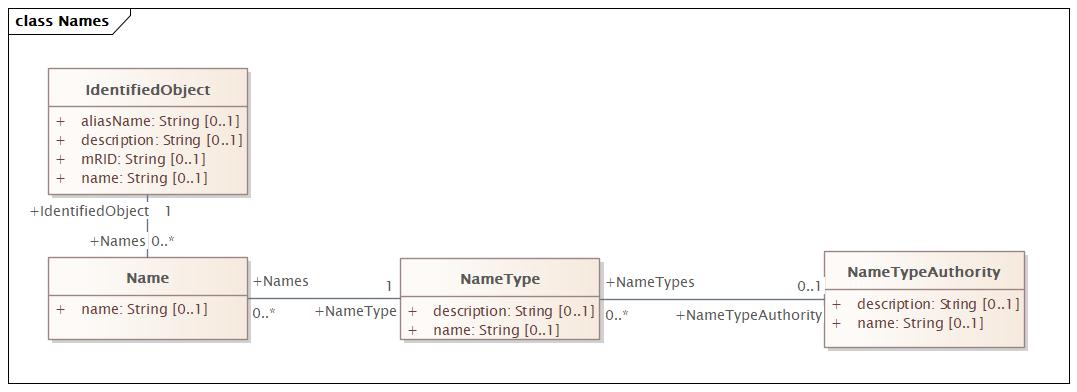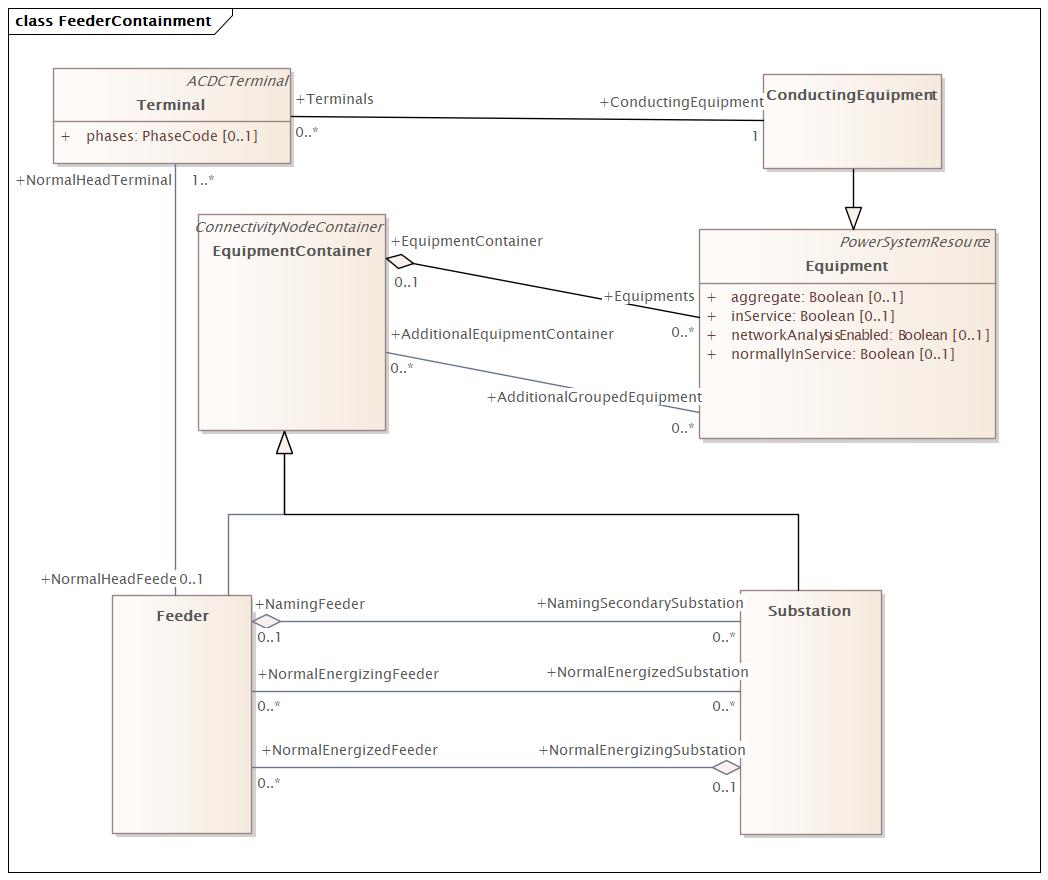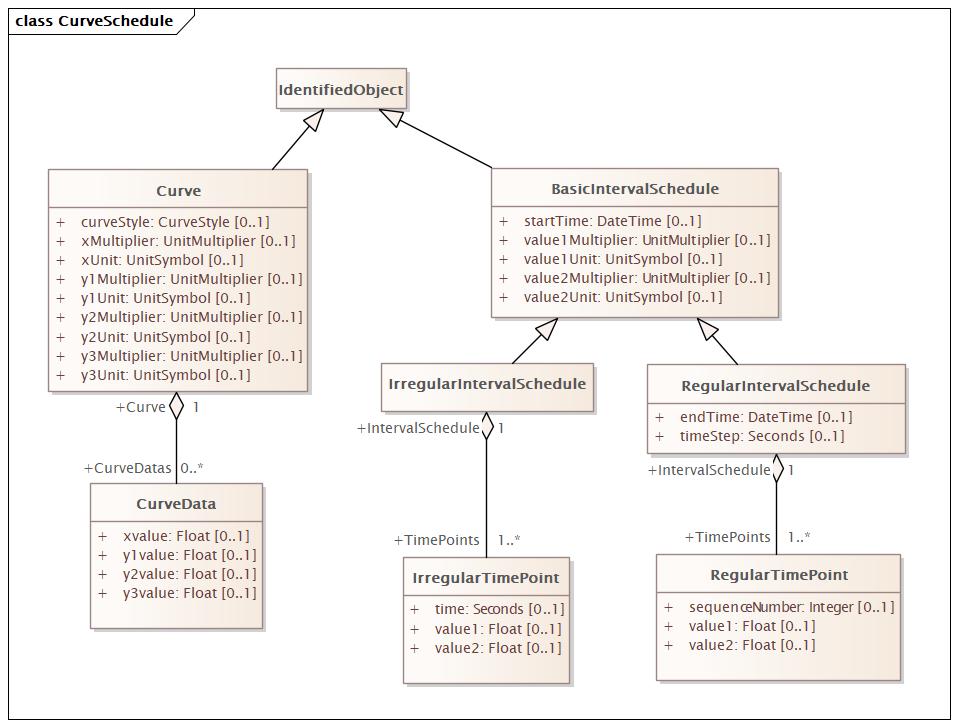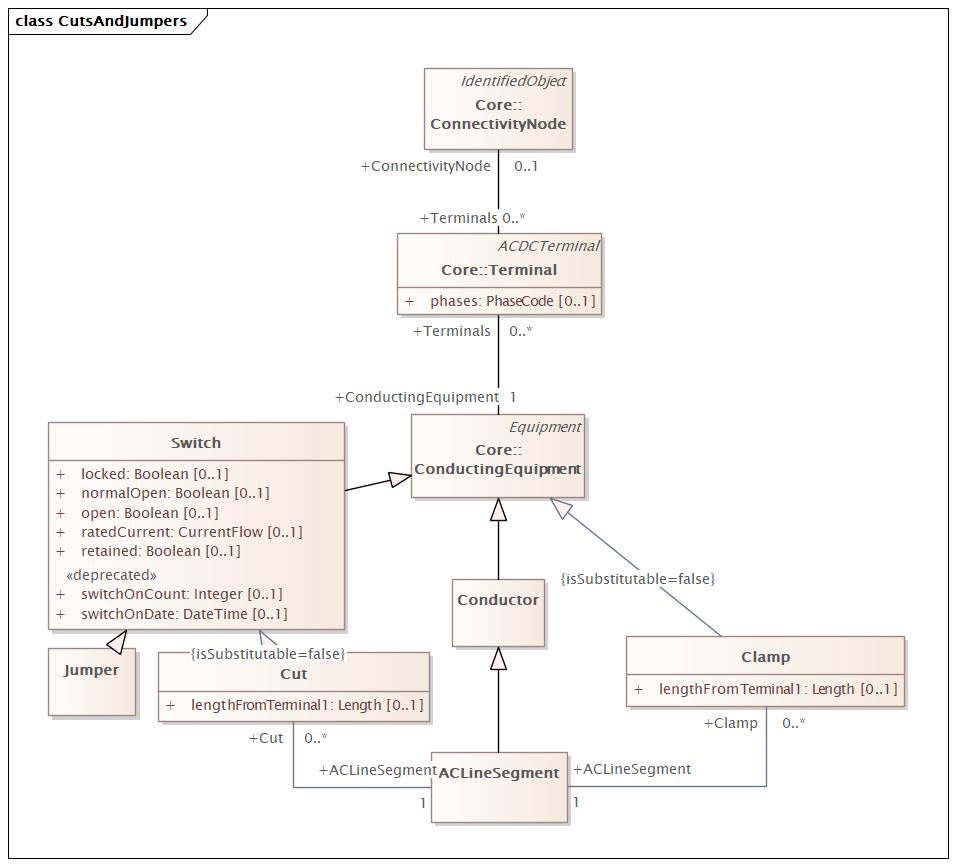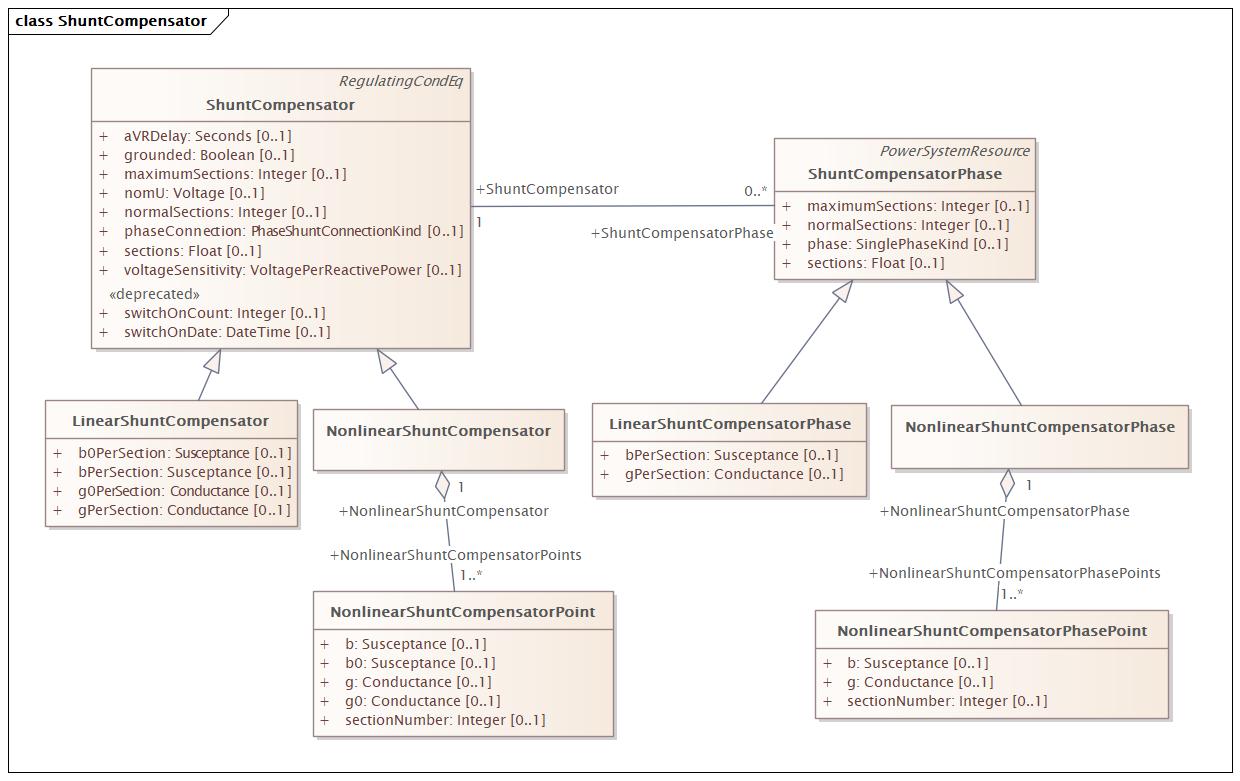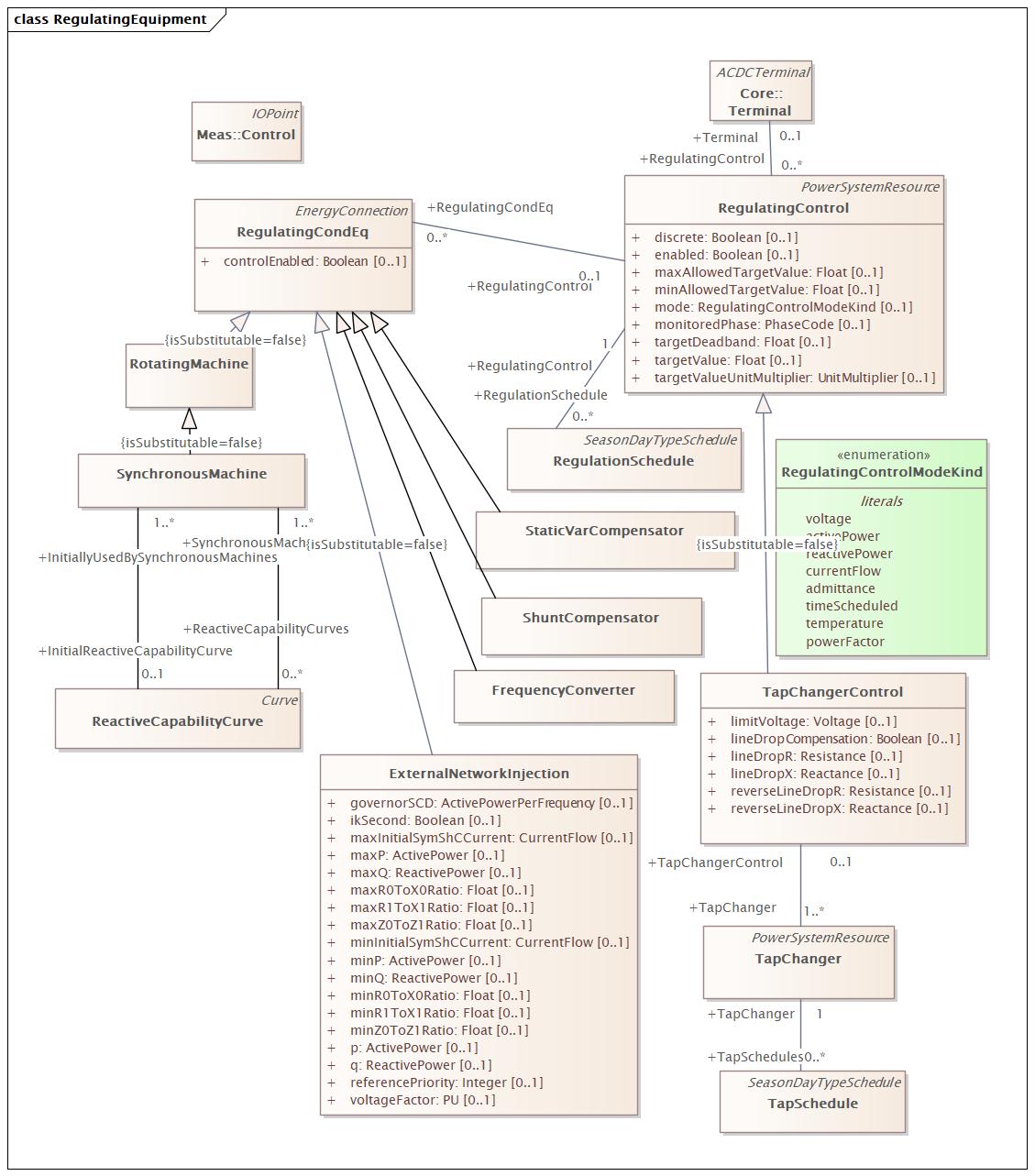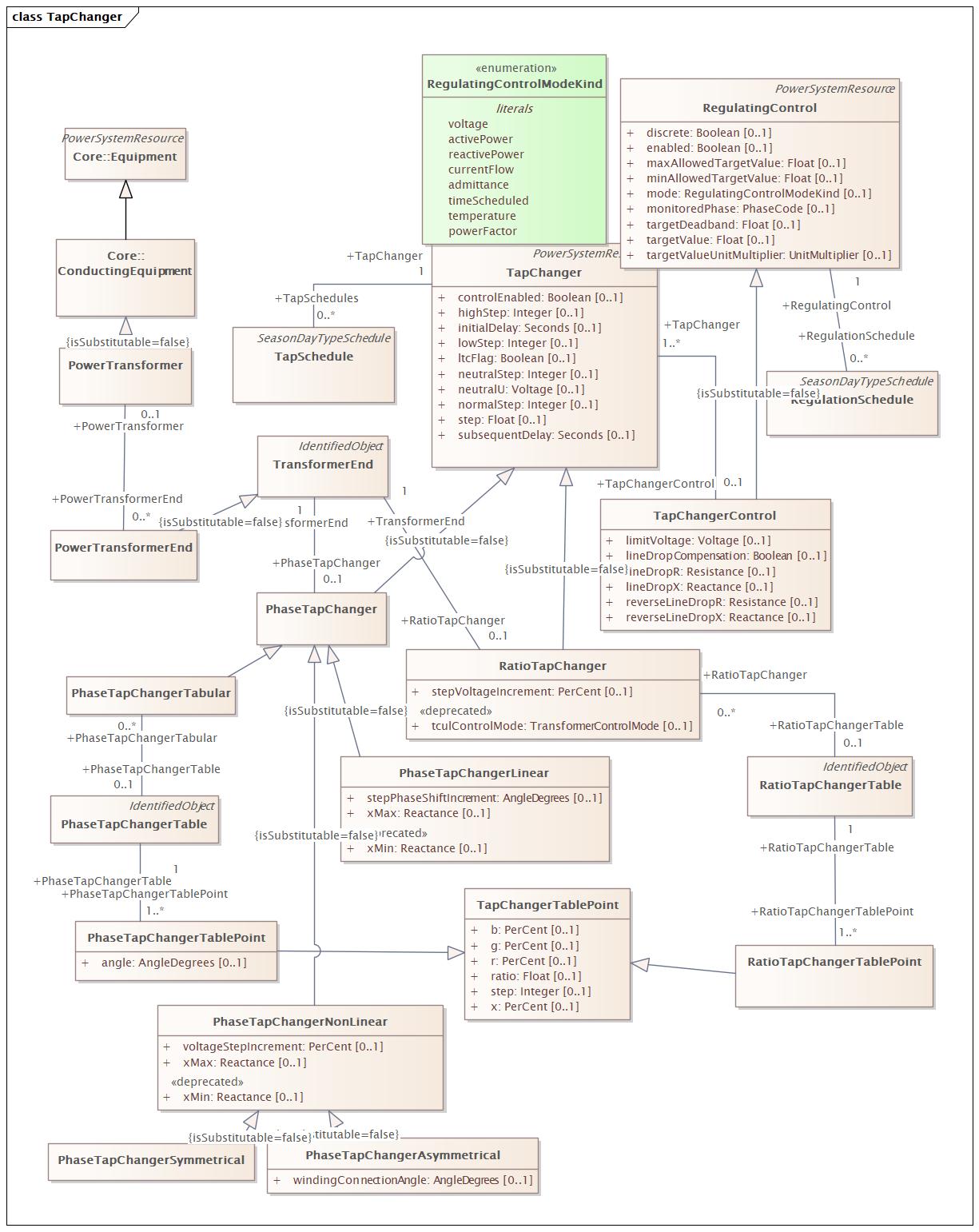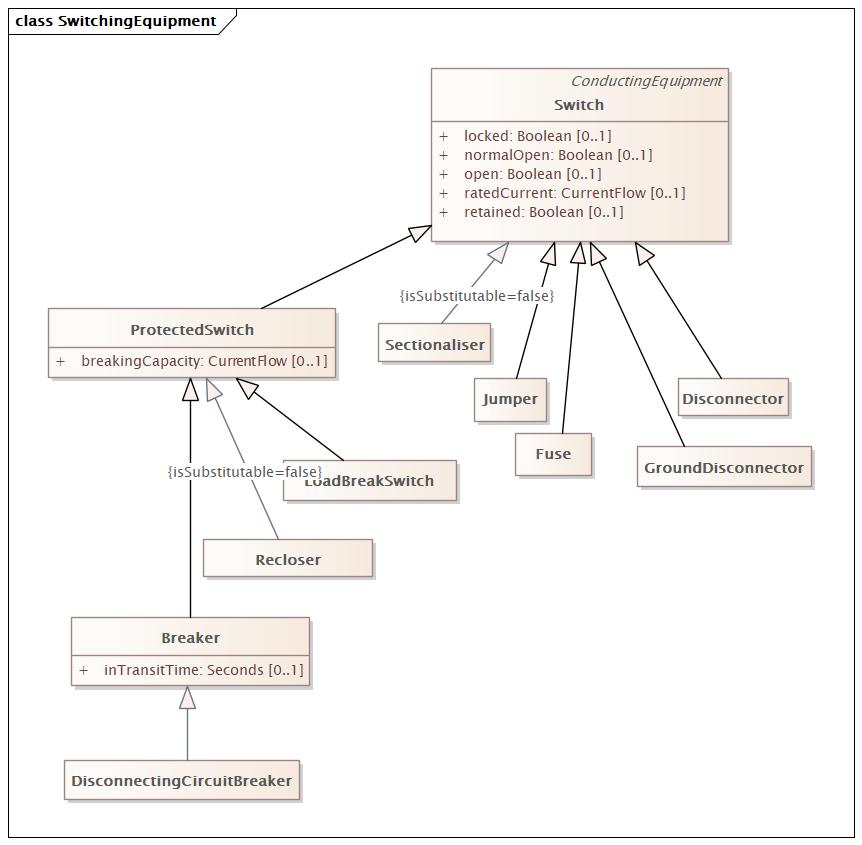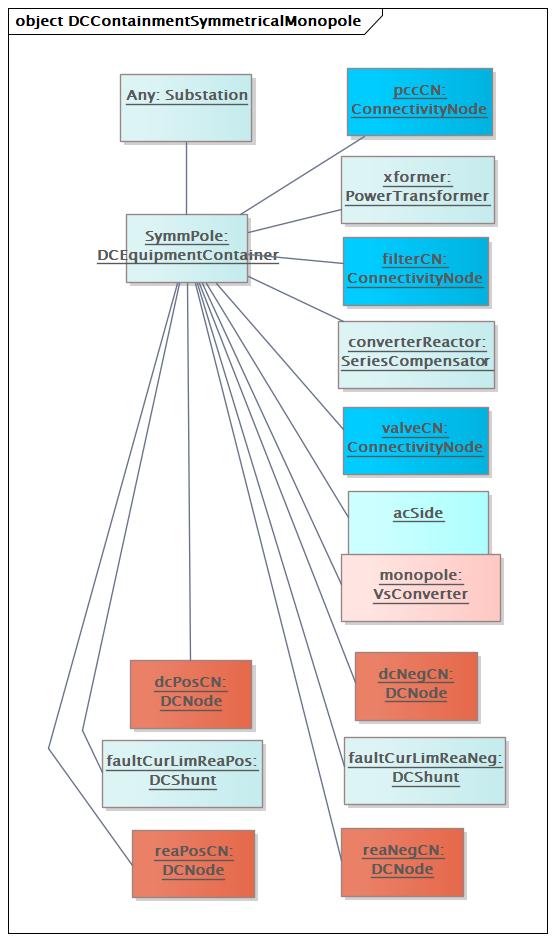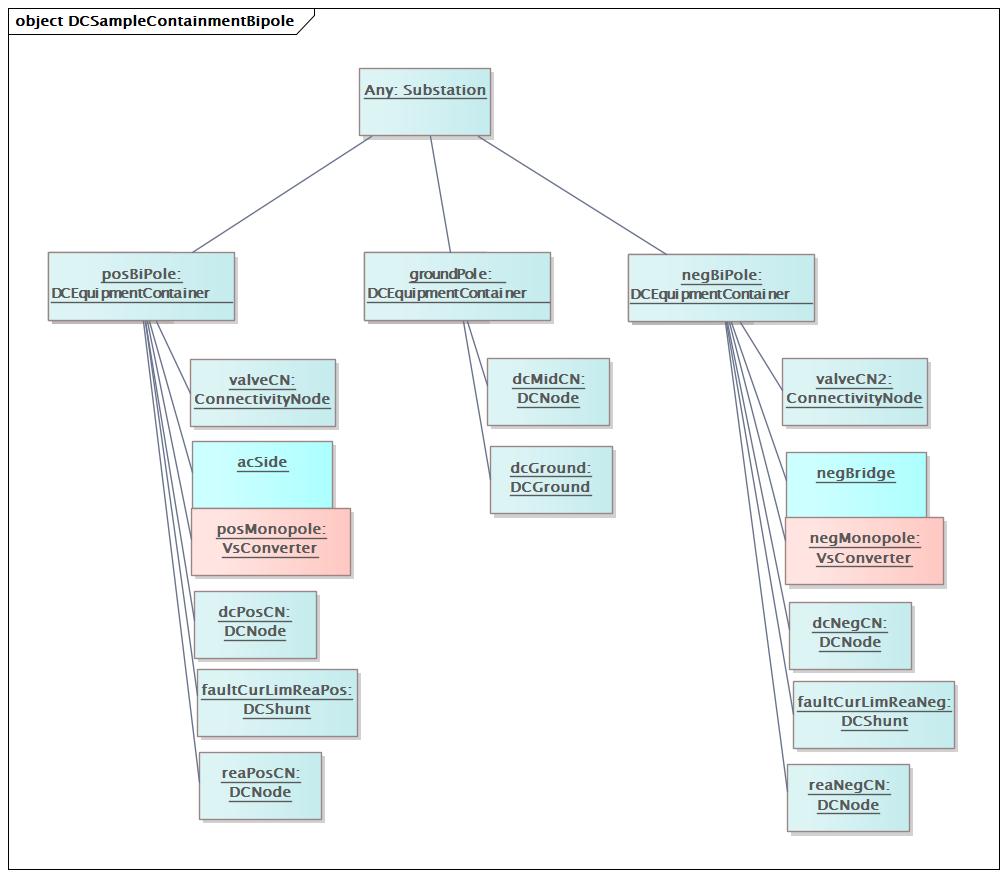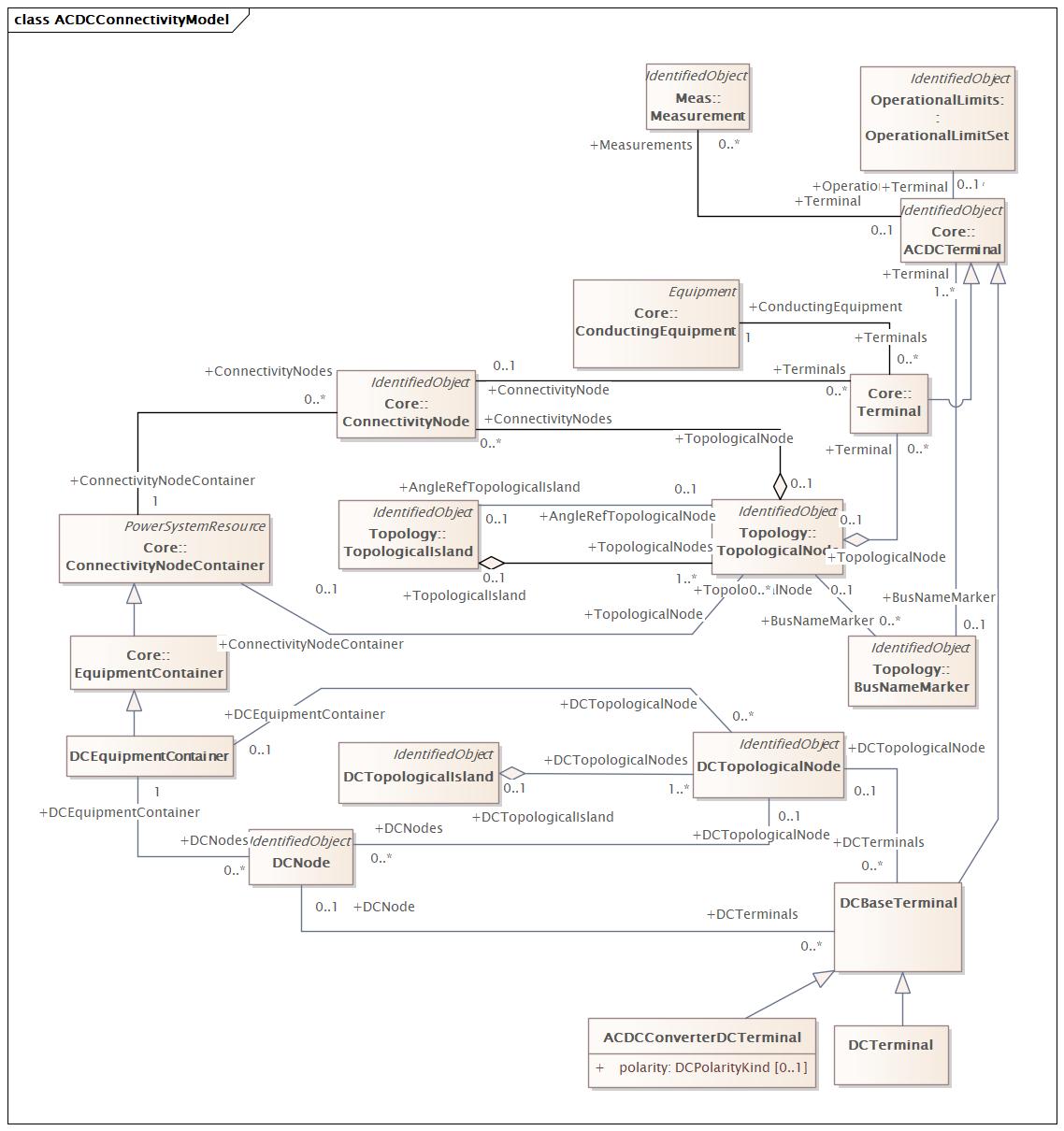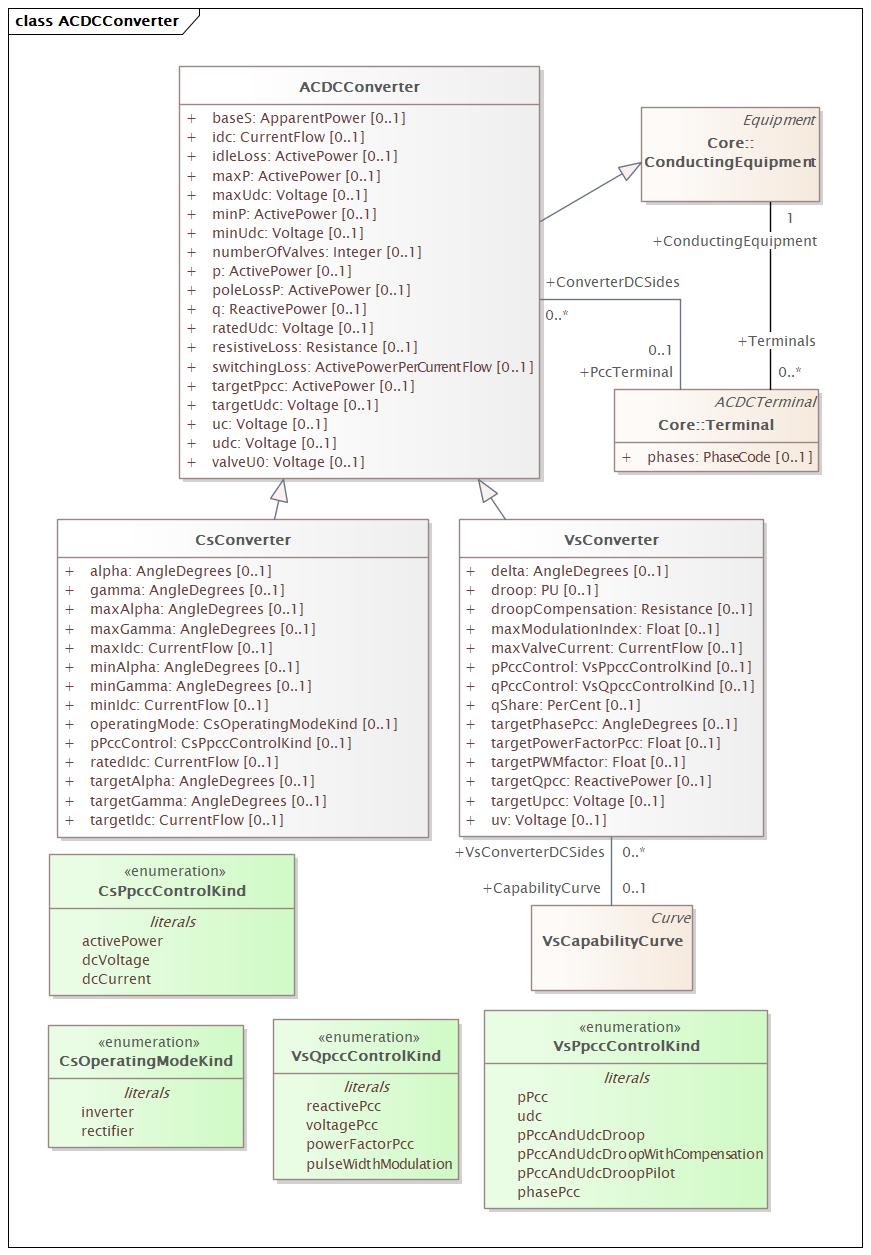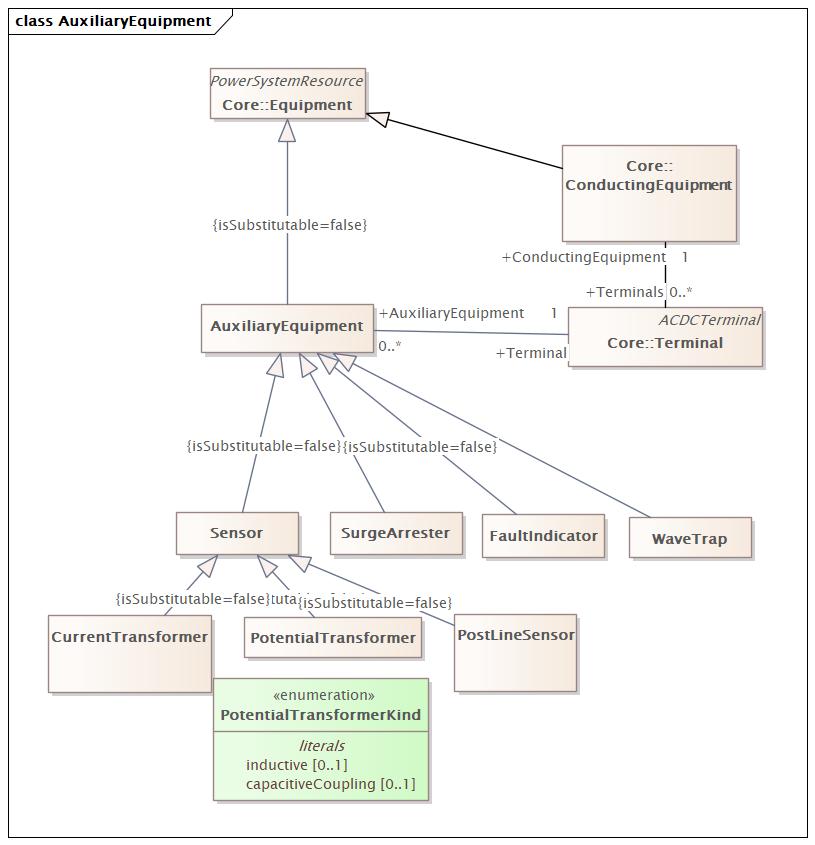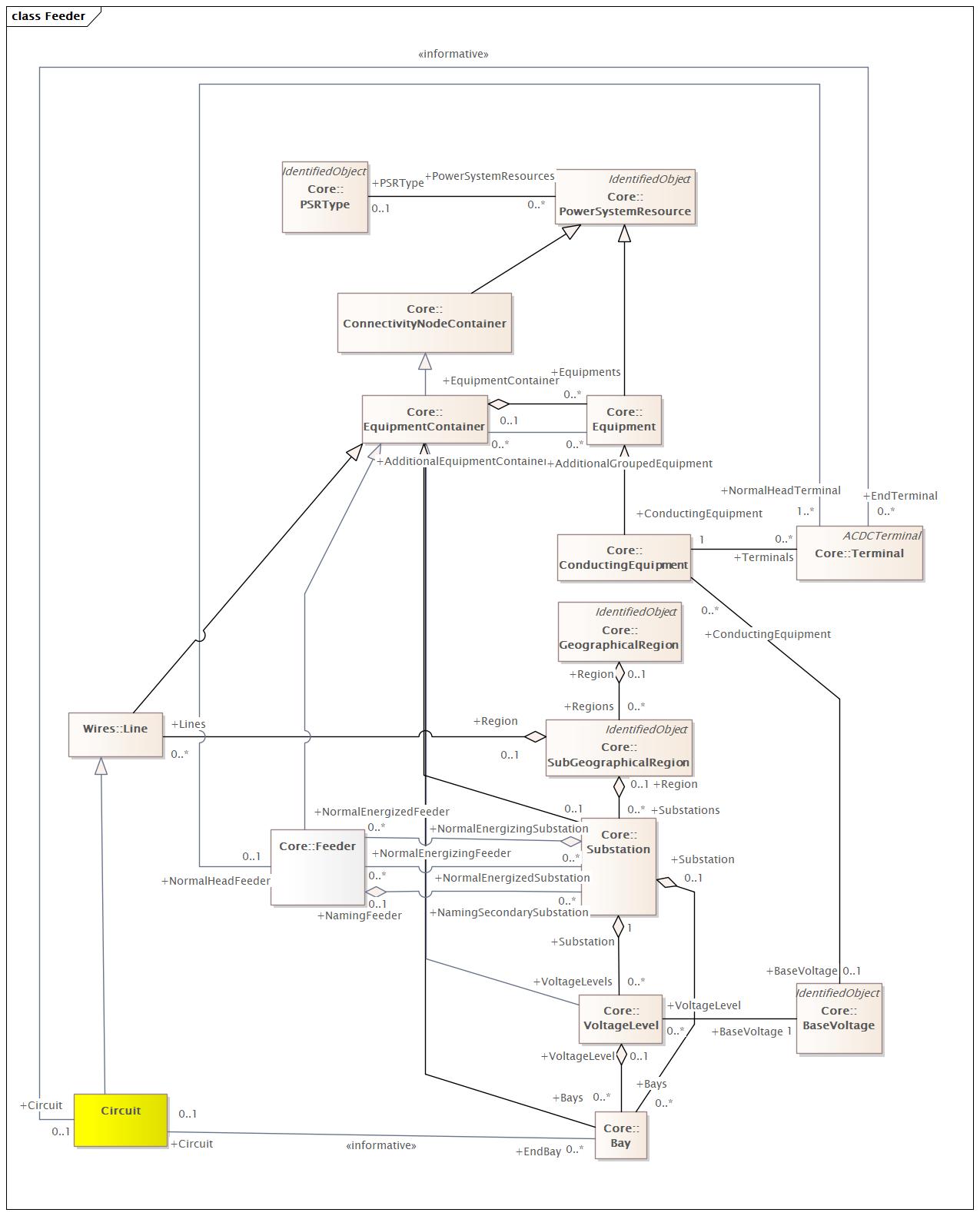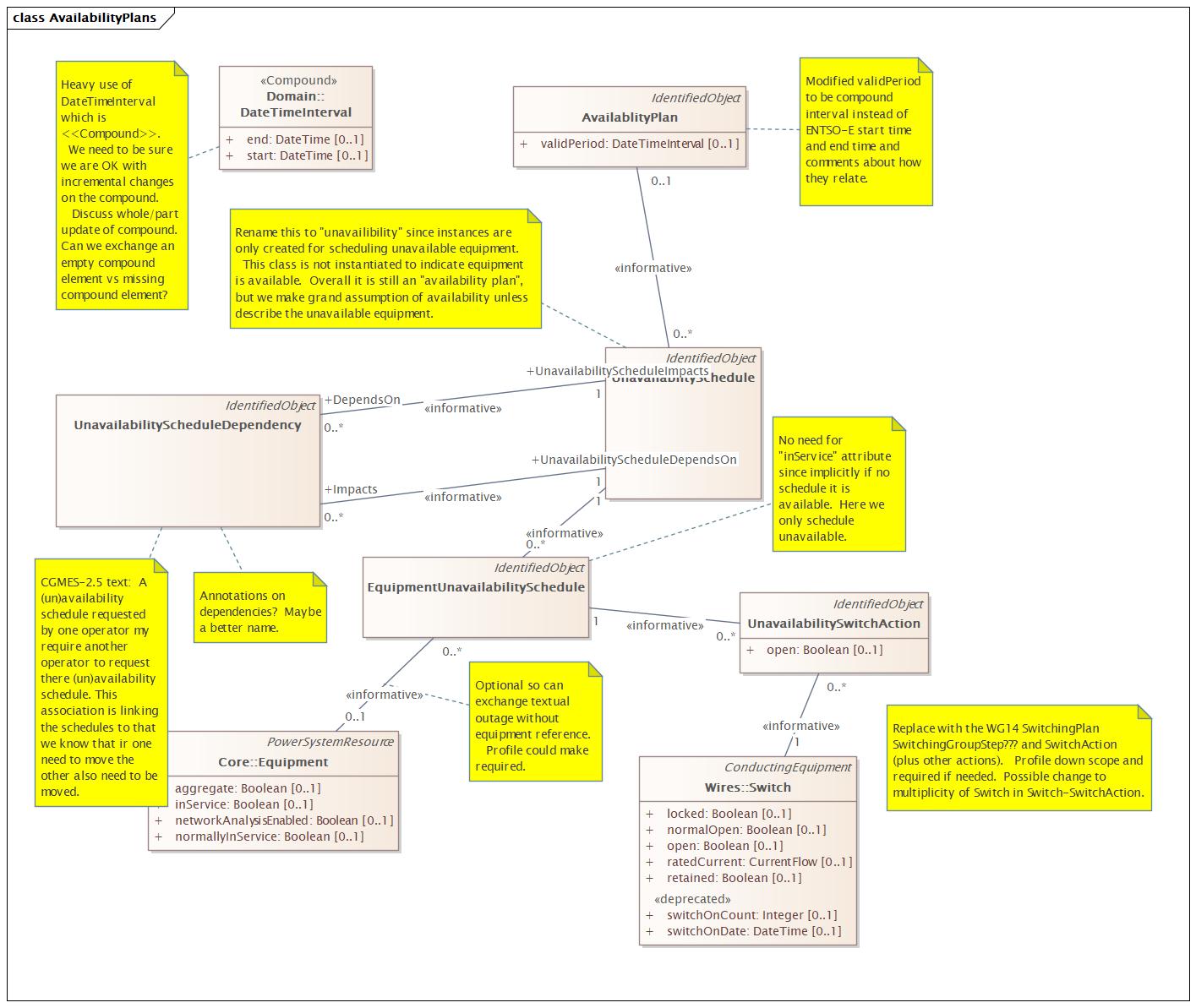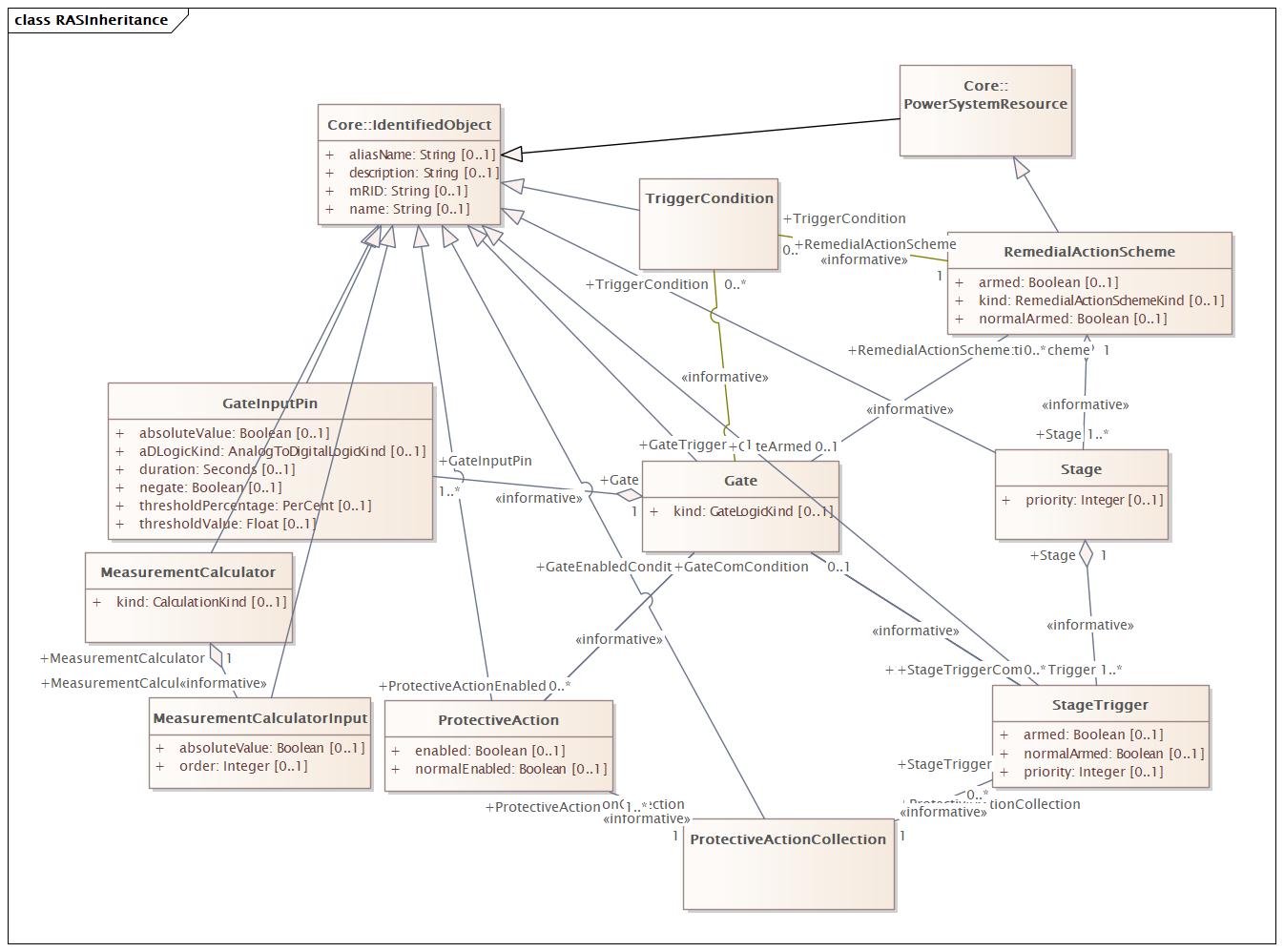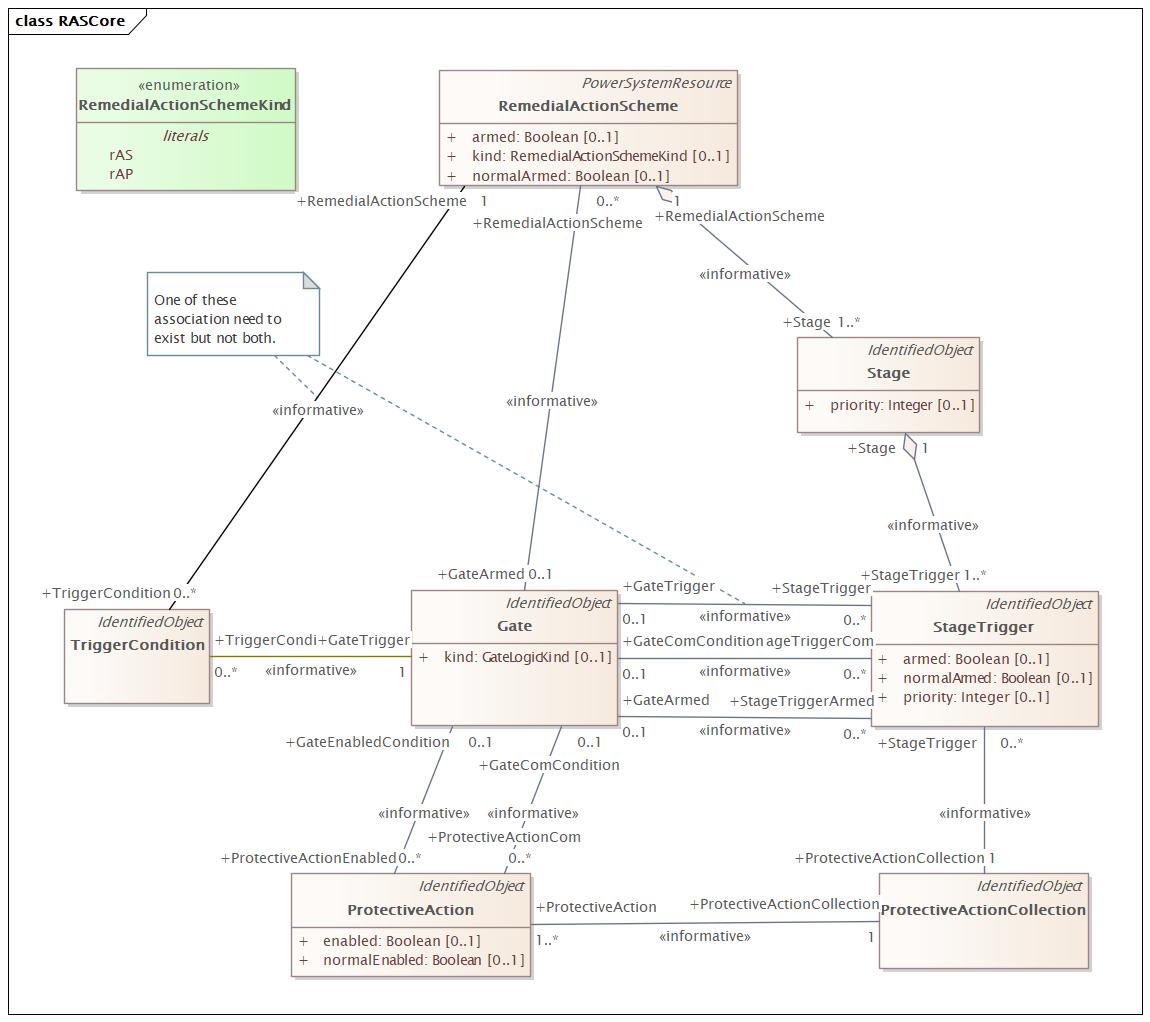Changed Classes:
Attributes:
|
Baseline Model |
Destination Model |
||||||||||||||||||||
|---|---|---|---|---|---|---|---|---|---|---|---|---|---|---|---|---|---|---|---|---|---|
|
kg |
Attribute 'kg' Metadata:
|
1..1 |
Mass in kilograms. Note: multiplier “k” is included in this unit symbol for compatibility with IEC 61850-7-3. |
kg |
Attribute 'kg' Metadata:
|
1..1 |
Mass in kilograms. Note: multiplier “k” is included in this unit symbol for compatibility with IEC 61850-7-3. |
||||||||||||||
Metadata:
|
|
Baseline Model |
Destination Model |
|---|---|---|
|
Notes |
Percentage on a defined base. For example, specify as 100 to indicate at the defined base. |
Percentage on a defined base. For example, specify as 100 to indicate at the defined base. |
Metadata:
|
|
Baseline Model |
Destination Model |
|---|---|---|
|
Notes |
The unit multipliers defined for the CIM. When applied to unit symbols, the unit symbol is treated as a derived unit. Regardless of the contents of the unit symbol text, the unit symbol shall be treated as if it were a single-character unit symbol. Unit symbols should not contain multipliers, and it should be left to the multiplier to define the multiple for an entire data type. For example, if a unit symbol is "m2Pers" and the multiplier is "k", then the value is k(m**2/s), and the multiplier applies to the entire final value, not to any individual part of the value. This can be conceptualized by substituting a derived unit symbol for the unit type. If one imagines that the symbol "Þ" represents the derived unit "m2Pers", then applying the multiplier "k" can be conceptualized simply as "kÞ".For example, the SI unit for mass is "kg" and not "g". If the unit symbol is defined as "kg", then the multiplier is applied to "kg" as a whole and does not replace the "k" in front of the "g". In this case, the multiplier of "m" would be used with the unit symbol of "kg" to represent one gram. As a text string, this violates the instructions in IEC 80000-1. However, because the unit symbol in CIM is treated as a derived unit instead of as an SI unit, it makes more sense to conceptualize the "kg" as if it were replaced by one of the proposed replacements for the SI mass symbol. If one imagines that the "kg" were replaced by a symbol "Þ", then it is easier to conceptualize the multiplier "m" as creating the proper unit "mÞ", and not the forbidden unit "mkg". |
The unit multipliers defined for the CIM. When applied to unit symbols, the unit symbol is treated as a derived unit. Regardless of the contents of the unit symbol text, the unit symbol shall be treated as if it were a single-character unit symbol. Unit symbols should not contain multipliers, and it should be left to the multiplier to define the multiple for an entire data type. For example, if a unit symbol is "m2Pers" and the multiplier is "k", then the value is k(m**2/s), and the multiplier applies to the entire final value, not to any individual part of the value. This can be conceptualized by substituting a derived unit symbol for the unit type. If one imagines that the symbol "Þ" represents the derived unit "m2Pers", then applying the multiplier "k" can be conceptualized simply as "kÞ".For example, the SI unit for mass is "kg" and not "g". If the unit symbol is defined as "kg", then the multiplier is applied to "kg" as a whole and does not replace the "k" in front of the "g". In this case, the multiplier of "m" would be used with the unit symbol of "kg" to represent one gram. As a text string, this violates the instructions in IEC 80000-1. However, because the unit symbol in CIM is treated as a derived unit instead of as an SI unit, it makes more sense to conceptualize the "kg" as if it were replaced by one of the proposed replacements for the SI mass symbol. If one imagines that the "kg" were replaced by a symbol "Þ", then it is easier to conceptualize the multiplier "m" as creating the proper unit "mÞ", and not the forbidden unit "mkg". |
Added Classes:
Metadata:
|
|
Baseline Model |
Destination Model |
|---|---|---|
|
Abstract |
|
false |
|
Alias |
| |
|
Author |
|
tviegut |
|
Cardinality |
| |
|
Classifier |
| |
|
Complexity |
|
1 |
|
Concurrency |
| |
|
GenFile |
| |
|
GenType |
|
Java |
|
IsLeaf |
|
false |
|
IsRoot |
|
false |
|
IsSpec |
|
false |
|
Keywords |
| |
|
Multiplicity |
| |
|
Name |
|
NamingAuthority |
|
Notes |
|
Authority responsible for creation and management of names of a given name type and/or name; typically an organization or an enterprise system. |
|
ParentPackage |
|
Core |
|
Persistence |
| |
|
Phase |
|
1.0 |
|
Scope |
|
public |
|
Status |
|
Proposed |
|
Stereotype |
| |
|
Style |
| |
|
Type |
|
Class |
|
Version |
|
1.0 |
|
Visibility |
|
Attributes:
|
Baseline Model |
Destination Model |
||||||||||||||||||||||||||||||||||||||||||||||||||||||||||||||||||||
|---|---|---|---|---|---|---|---|---|---|---|---|---|---|---|---|---|---|---|---|---|---|---|---|---|---|---|---|---|---|---|---|---|---|---|---|---|---|---|---|---|---|---|---|---|---|---|---|---|---|---|---|---|---|---|---|---|---|---|---|---|---|---|---|---|---|---|---|---|---|
|
ATTRIBUTE DOES NOT EXIST |
description |
Attribute 'description' Metadata:
|
0..1 |
Description of the naming authority. |
|||||||||||||||||||||||||||||||||||||||||||||||||||||||||||||||||
|
ATTRIBUTE DOES NOT EXIST |
mRID |
Attribute 'mRID' Metadata:
|
0..1 |
Master resource identifier issued by a model authority. The mRID is unique within an exchange context. Global uniqueness is easily achieved by using a UUID, as specified in RFC 4122, for the mRID. The use of UUID is strongly recommended.For CIMXML data files in RDF syntax conforming to IEC 61970-552, the mRID is mapped to rdf:ID or rdf:about attributes that identify CIM object elements. |
|||||||||||||||||||||||||||||||||||||||||||||||||||||||||||||||||
|
ATTRIBUTE DOES NOT EXIST |
name |
Attribute 'name' Metadata:
|
0..1 |
Name of the naming authority. |
|||||||||||||||||||||||||||||||||||||||||||||||||||||||||||||||||
Links:
Association:
Metadata:
|
|
Baseline Model |
Destination Model |
|---|---|---|
|
Alias |
| |
|
Direction |
|
Unspecified |
|
IsLeaf |
|
false |
|
IsRoot |
|
false |
|
Notes |
| |
|
Source Linked Feature |
| |
|
Stereotype |
| |
|
Target Linked Feature |
| |
|
Type |
|
Association |
|
Baseline Model |
|
Destination Model |
|||||||
|---|---|---|---|---|---|---|---|---|---|
|
|
|
|
|
Source Role End Changes |
|
Target Role End Changes |
||||||||||||||||||||||||||||||||||||||||||||||||||||||||||||||||||||||||||||||||||||||||||||||||||||||
|---|---|---|---|---|---|---|---|---|---|---|---|---|---|---|---|---|---|---|---|---|---|---|---|---|---|---|---|---|---|---|---|---|---|---|---|---|---|---|---|---|---|---|---|---|---|---|---|---|---|---|---|---|---|---|---|---|---|---|---|---|---|---|---|---|---|---|---|---|---|---|---|---|---|---|---|---|---|---|---|---|---|---|---|---|---|---|---|---|---|---|---|---|---|---|---|---|---|---|---|---|---|---|---|---|
|
|
|
|
Association:
Metadata:
|
|
Baseline Model |
Destination Model |
|---|---|---|
|
Alias |
| |
|
Direction |
|
Unspecified |
|
IsLeaf |
|
false |
|
IsRoot |
|
false |
|
Notes |
| |
|
Source Linked Feature |
| |
|
Stereotype |
| |
|
Target Linked Feature |
| |
|
Type |
|
Association |
|
Baseline Model |
|
Destination Model |
|||||||
|---|---|---|---|---|---|---|---|---|---|
|
|
|
|
|
Source Role End Changes |
|
Target Role End Changes |
||||||||||||||||||||||||||||||||||||||||||||||||||||||||||||||||||||||||||||||||||||||||||||||||||||||
|---|---|---|---|---|---|---|---|---|---|---|---|---|---|---|---|---|---|---|---|---|---|---|---|---|---|---|---|---|---|---|---|---|---|---|---|---|---|---|---|---|---|---|---|---|---|---|---|---|---|---|---|---|---|---|---|---|---|---|---|---|---|---|---|---|---|---|---|---|---|---|---|---|---|---|---|---|---|---|---|---|---|---|---|---|---|---|---|---|---|---|---|---|---|---|---|---|---|---|---|---|---|---|---|---|
|
|
|
|
Metadata:
|
|
Baseline Model |
Destination Model |
|---|---|---|
|
Abstract |
|
false |
|
Alias |
| |
|
Author |
|
tviegut |
|
Cardinality |
| |
|
Classifier |
| |
|
Complexity |
|
1 |
|
Concurrency |
| |
|
GenFile |
| |
|
GenType |
|
Java |
|
IsLeaf |
|
false |
|
IsRoot |
|
false |
|
IsSpec |
|
false |
|
Keywords |
| |
|
Multiplicity |
| |
|
Name |
|
ObjectType |
|
Notes |
|
Identifies the specialised type of an object when the instance object is serialised using a generalised class. It may be useful when the object type is not otherwise included in the exchange. For example, a Meter may be serialised as an EndDevice in message exchanges and need to have the ObjectType.type be specified as 'Meter' to provide context to the message receiver. |
|
ParentPackage |
|
Core |
|
Persistence |
| |
|
Phase |
|
1.0 |
|
Scope |
|
public |
|
Status |
|
Proposed |
|
Stereotype |
| |
|
Style |
| |
|
Type |
|
Class |
|
Version |
|
1.0 |
|
Visibility |
|
Attributes:
|
Baseline Model |
Destination Model |
||||||||||||||||||||||||||||||||||||||||||||||||||||||||||||||||||||
|---|---|---|---|---|---|---|---|---|---|---|---|---|---|---|---|---|---|---|---|---|---|---|---|---|---|---|---|---|---|---|---|---|---|---|---|---|---|---|---|---|---|---|---|---|---|---|---|---|---|---|---|---|---|---|---|---|---|---|---|---|---|---|---|---|---|---|---|---|---|
|
ATTRIBUTE DOES NOT EXIST |
type |
Attribute 'type' Metadata:
|
0..1 | ||||||||||||||||||||||||||||||||||||||||||||||||||||||||||||||||||
Links:
Association:
Metadata:
|
|
Baseline Model |
Destination Model |
|---|---|---|
|
Alias |
| |
|
Direction |
|
Unspecified |
|
IsLeaf |
|
false |
|
IsRoot |
|
false |
|
Notes |
| |
|
Source Linked Feature |
| |
|
Stereotype |
| |
|
Target Linked Feature |
| |
|
Type |
|
Association |
|
Baseline Model |
|
Destination Model |
|||||||
|---|---|---|---|---|---|---|---|---|---|
|
|
|
|
|
Source Role End Changes |
|
Target Role End Changes |
||||||||||||||||||||||||||||||||||||||||||||||||||||||||||||||||||||||||||||||||||||||||||||||||||||||
|---|---|---|---|---|---|---|---|---|---|---|---|---|---|---|---|---|---|---|---|---|---|---|---|---|---|---|---|---|---|---|---|---|---|---|---|---|---|---|---|---|---|---|---|---|---|---|---|---|---|---|---|---|---|---|---|---|---|---|---|---|---|---|---|---|---|---|---|---|---|---|---|---|---|---|---|---|---|---|---|---|---|---|---|---|---|---|---|---|---|---|---|---|---|---|---|---|---|---|---|---|---|---|---|---|
|
|
|
|
Changed Classes:
Links:
Association:
Metadata:
|
|
Baseline Model |
Destination Model |
|---|---|---|
|
Stereotype |
|
Part 3 Ext |
|
Baseline Model |
|
Destination Model |
||||||||||||
|---|---|---|---|---|---|---|---|---|---|---|---|---|---|---|
|
|
|
|
|
Source Role End Changes |
|
Target Role End Changes |
||||||||||||||||||
|---|---|---|---|---|---|---|---|---|---|---|---|---|---|---|---|---|---|---|---|---|
|
|
|
|
Association:
|
Baseline Model |
|
Destination Model |
||||||||||||
|---|---|---|---|---|---|---|---|---|---|---|---|---|---|---|
|
|
|
|
|
Source Role End Changes |
|
Target Role End Changes |
||||||||||||
|---|---|---|---|---|---|---|---|---|---|---|---|---|---|---|
|
|
|
|
Association:
|
Baseline Model |
|
Destination Model |
||||||||||||
|---|---|---|---|---|---|---|---|---|---|---|---|---|---|---|
|
|
|
|
|
Source Role End Changes |
|
Target Role End Changes |
||||||||||||
|---|---|---|---|---|---|---|---|---|---|---|---|---|---|---|
|
|
|
|
Metadata:
|
|
Baseline Model |
Destination Model |
|---|---|---|
|
Notes |
An operator of multiple power system resource objects. Note multple operating participants may operate the same power system resource object. This can be used for modeling jointly owned units where each owner operates as a contractual share. |
An operator of multiple power system resource objects. Note multiple operating participants may operate the same power system resource object. This can be used for modeling jointly owned units where each owner operates as a contractual share. |
Attributes:
|
Baseline Model |
Destination Model |
||||||||||||||||||||
|---|---|---|---|---|---|---|---|---|---|---|---|---|---|---|---|---|---|---|---|---|---|
|
aliasName |
Attribute 'aliasName' Metadata:
|
0..1 |
The aliasName is free text human readable name of the object alternative to IdentifiedObject.name. It may be non unique and may not correlate to a naming hierarchy.The attribute aliasName is retained because of backwards compatibility between CIM relases. It is however recommended to replace aliasName with the Name class as aliasName is planned for retirement at a future time. |
aliasName |
Attribute 'aliasName' Metadata:
|
0..1 |
The aliasName is free text human readable name of the object alternative to IdentifiedObject.name. It may be non unique and may not correlate to a naming hierarchy.The attribute aliasName is retained because of backwards compatibility between CIM releases. It is however recommended to replace aliasName with the Name class as aliasName is planned for retirement at a future time. |
||||||||||||||
|
mRID |
Attribute 'mRID' Metadata:
|
0..1 |
Master resource identifier issued by a model authority. The mRID is unique within an exchange context. Global uniqueness is easily achieved by using a UUID, as specified in RFC 4122, for the mRID. The use of UUID is strongly recommended.For CIMXML data files in RDF syntax conforming to IEC 61970-552, the mRID is mapped to rdf:ID or rdf:about attributes that identify CIM object elements. |
mRID |
Attribute 'mRID' Metadata:
|
0..1 |
Master resource identifier issued by a model authority. The mRID is unique within an exchange context. Global uniqueness is easily achieved by using a UUID, as specified in IETF RFC 4122, for the mRID. The use of UUID is strongly recommended.For CIMXML data files in RDF syntax conforming to IEC 61970-552, the mRID is mapped to rdf:ID or rdf:about attributes that identify CIM object elements. |
||||||||||||||
Links:
Association:
|
Baseline Model |
|
Destination Model |
||||||||||||
|---|---|---|---|---|---|---|---|---|---|---|---|---|---|---|
|
|
|
|
|
Source Role End Changes |
|
Target Role End Changes |
|||||||||||||||
|---|---|---|---|---|---|---|---|---|---|---|---|---|---|---|---|---|---|
|
|
|
|
Association:
Metadata:
|
|
Baseline Model |
Destination Model |
|---|---|---|
|
Alias |
| |
|
Direction |
|
Unspecified |
|
IsLeaf |
|
false |
|
IsRoot |
|
false |
|
Notes |
| |
|
Source Linked Feature |
| |
|
Stereotype |
| |
|
Target Linked Feature |
| |
|
Type |
|
Association |
|
Baseline Model |
|
Destination Model |
|||||||
|---|---|---|---|---|---|---|---|---|---|
|
|
|
|
|
Source Role End Changes |
|
Target Role End Changes |
||||||||||||||||||||||||||||||||||||||||||||||||||||||||||||||||||||||||||||||||||||||||||||||||||||||
|---|---|---|---|---|---|---|---|---|---|---|---|---|---|---|---|---|---|---|---|---|---|---|---|---|---|---|---|---|---|---|---|---|---|---|---|---|---|---|---|---|---|---|---|---|---|---|---|---|---|---|---|---|---|---|---|---|---|---|---|---|---|---|---|---|---|---|---|---|---|---|---|---|---|---|---|---|---|---|---|---|---|---|---|---|---|---|---|---|---|---|---|---|---|---|---|---|---|---|---|---|---|---|---|---|
|
|
|
|
Association:
Metadata:
|
|
Baseline Model |
Destination Model |
|---|---|---|
|
Alias |
| |
|
Direction |
|
Unspecified |
|
IsLeaf |
|
false |
|
IsRoot |
|
false |
|
Notes |
| |
|
Source Linked Feature |
| |
|
Stereotype |
| |
|
Target Linked Feature |
| |
|
Type |
|
Association |
|
Baseline Model |
|
Destination Model |
|||||||
|---|---|---|---|---|---|---|---|---|---|
|
|
|
|
|
Source Role End Changes |
|
Target Role End Changes |
||||||||||||||||||||||||||||||||||||||||||||||||||||||||||||||||||||||||||||||||||||||||||||||||||||||
|---|---|---|---|---|---|---|---|---|---|---|---|---|---|---|---|---|---|---|---|---|---|---|---|---|---|---|---|---|---|---|---|---|---|---|---|---|---|---|---|---|---|---|---|---|---|---|---|---|---|---|---|---|---|---|---|---|---|---|---|---|---|---|---|---|---|---|---|---|---|---|---|---|---|---|---|---|---|---|---|---|---|---|---|---|---|---|---|---|---|---|---|---|---|---|---|---|---|---|---|---|---|---|---|---|
|
|
|
|
Attributes:
|
Baseline Model |
Destination Model |
||||||||||||||||||||
|---|---|---|---|---|---|---|---|---|---|---|---|---|---|---|---|---|---|---|---|---|---|
|
phases |
Attribute 'phases' Metadata:
|
0..1 |
Represents the normal network phasing condition. If the attribute is missing, three phases (ABC) shall be assumed, except for terminals of grounding classes (specializations of EarthFaultCompensator, GroundDisconnector, and Ground) which will be assumed to be N. Therefore, phase code ABCN is explicitly declared when needed, e.g. for star point grounding equipment.The phase code on terminals connecting same ConnectivityNode or same TopologicalNode as well as for equipment between two terminals shall be consistent. |
phases |
Attribute 'phases' Metadata:
|
0..1 |
Represents the normal network phasing condition. If the attribute is missing, three phases (ABC) shall be assumed, except for terminals of grounding classes (specializations of EarthFaultCompensator, GroundDisconnector, and Ground) which will be assumed to be N. Therefore, phase code ABCN is explicitly declared when needed, e.g. for star point grounding equipment.The phase code on terminals connecting the same ConnectivityNode or TopologicalNode as well as for equipment between two terminals shall be consistent. |
||||||||||||||
Attributes:
|
Baseline Model |
Destination Model |
||||||||||||||||||||
|---|---|---|---|---|---|---|---|---|---|---|---|---|---|---|---|---|---|---|---|---|---|
|
nominalVoltage |
Attribute 'nominalVoltage' Metadata:
|
0..1 |
The power system resource's base voltage. Shall be a positive value and not zero. |
nominalVoltage |
Attribute 'nominalVoltage' Metadata:
|
0..1 |
The power system resource's base voltage. Shall be a positive value and not zero. |
||||||||||||||
Links:
Association:
|
Baseline Model |
|
Destination Model |
||||||||||||
|---|---|---|---|---|---|---|---|---|---|---|---|---|---|---|
|
|
|
|
|
Source Role End Changes |
|
Target Role End Changes |
||||||||||||
|---|---|---|---|---|---|---|---|---|---|---|---|---|---|---|
|
|
|
|
Metadata:
|
|
Baseline Model |
Destination Model |
|---|---|---|
|
Notes |
An unordered enumeration of phase identifiers. Allows designation of phases for both transmission and distribution equipment, circuits and loads. The enumeration, by itself, does not describe how the phases are connected together or connected to ground. Ground is not explicitly denoted as a phase.Residential and small commercial loads are often served from single-phase, or split-phase, secondary circuits. For the example of s12N, phases 1 and 2 refer to hot wires that are 180 degrees out of phase, while N refers to the neutral wire. Through single-phase transformer connections, these secondary circuits may be served from one or two of the primary phases A, B, and C. For three-phase loads, use the A, B, C phase codes instead of s12N.The integer values are from IEC 61968-9 to support revenue metering applications. |
Enumeration of phase identifiers used to designate the combination of phase and/or neutral conductors at a terminal, measurement or equipment modelled as a single-line balanced equivalent.This is an unordered enumeration of phase identifiers. Allows designation of phases for both transmission and distribution equipment, circuits and loads. The enumeration, by itself, does not describe how the phases are connected together or connected to ground. Ground is not explicitly denoted as a phase.Residential and small commercial loads are often served from single-phase, or split-phase, secondary circuits. For the example of s12N, phases 1 and 2 refer to hot wires that are 180 degrees out of phase, while N refers to the neutral wire. Through single-phase transformer connections, these secondary circuits may be served from one or two of the primary phases A, B, and C. For three-phase loads, use the A, B, C phase codes instead of s12N.The integer values are from IEC 61968-9 to support revenue metering applications. |
Attributes:
|
Baseline Model |
Destination Model |
||||||||||||||||||||
|---|---|---|---|---|---|---|---|---|---|---|---|---|---|---|---|---|---|---|---|---|---|
|
straightLineYValues |
Attribute 'straightLineYValues' Metadata:
|
1..1 |
The Y-axis values are assumed to be a straight line between values. Also known as linear interpolation. |
straightLineYValues |
Attribute 'straightLineYValues' Metadata:
|
1..1 |
The Y-axis values are assumed to be a straight line between values. Also known as linear interpolation. |
||||||||||||||
Links:
Association:
|
Baseline Model |
|
Destination Model |
|---|---|---|
|
|
|
|
|
Source Role End Changes |
|
Target Role End Changes |
||||||||||||
|---|---|---|---|---|---|---|---|---|---|---|---|---|---|---|
|
|
|
|
||||||||||||
Metadata:
|
|
Baseline Model |
Destination Model |
|---|---|---|
|
Notes |
Multi-purpose data points for defining a curve. The use of this generic class is discouraged if a more specific class can be used to specify the X and Y axis values along with their specific data types. |
Multi-purpose data points for defining a curve. The use of this generic class is discouraged if a more specific class can be used to specify the X and Y axis values along with their specific data types. |
Attributes:
|
Baseline Model |
Destination Model |
||||||||||||||||||||
|---|---|---|---|---|---|---|---|---|---|---|---|---|---|---|---|---|---|---|---|---|---|
|
xvalue |
Attribute 'xvalue' Metadata:
|
0..1 |
The data value of the X-axis variable, depending on the X-axis units. |
xvalue |
Attribute 'xvalue' Metadata:
|
0..1 |
The data value of the X-axis variable, depending on the X-axis units. |
||||||||||||||
Links:
Association:
|
Baseline Model |
|
Destination Model |
|---|---|---|
|
|
|
|
|
Source Role End Changes |
|
Target Role End Changes |
||||||||||||
|---|---|---|---|---|---|---|---|---|---|---|---|---|---|---|
|
|
|
|
||||||||||||
Attributes:
|
Baseline Model |
Destination Model |
||||||||||||||||||||||||||||||||||||||||||||||||||||||||||||||||||||
|---|---|---|---|---|---|---|---|---|---|---|---|---|---|---|---|---|---|---|---|---|---|---|---|---|---|---|---|---|---|---|---|---|---|---|---|---|---|---|---|---|---|---|---|---|---|---|---|---|---|---|---|---|---|---|---|---|---|---|---|---|---|---|---|---|---|---|---|---|---|
|
ATTRIBUTE DOES NOT EXIST |
mRID |
Attribute 'mRID' Metadata:
|
0..1 |
Master resource identifier issued by a model authority. The mRID is unique within an exchange context. Global uniqueness is easily achieved by using a UUID, as specified in RFC 4122, for the mRID. The use of UUID is strongly recommended.For CIMXML data files in RDF syntax conforming to IEC 61970-552, the mRID is mapped to rdf:ID or rdf:about attributes that identify CIM object elements. |
|||||||||||||||||||||||||||||||||||||||||||||||||||||||||||||||||
Links:
Association:
Metadata:
|
|
Baseline Model |
Destination Model |
|---|---|---|
|
Alias |
| |
|
Direction |
|
Unspecified |
|
IsLeaf |
|
false |
|
IsRoot |
|
false |
|
Notes |
| |
|
Source Linked Feature |
| |
|
Stereotype |
| |
|
Target Linked Feature |
| |
|
Type |
|
Association |
|
Baseline Model |
|
Destination Model |
|||||||
|---|---|---|---|---|---|---|---|---|---|
|
|
|
|
|
Source Role End Changes |
|
Target Role End Changes |
||||||||||||||||||||||||||||||||||||||||||||||||||||||||||||||||||||||||||||||||||||||||||||||||||||||
|---|---|---|---|---|---|---|---|---|---|---|---|---|---|---|---|---|---|---|---|---|---|---|---|---|---|---|---|---|---|---|---|---|---|---|---|---|---|---|---|---|---|---|---|---|---|---|---|---|---|---|---|---|---|---|---|---|---|---|---|---|---|---|---|---|---|---|---|---|---|---|---|---|---|---|---|---|---|---|---|---|---|---|---|---|---|---|---|---|---|---|---|---|---|---|---|---|---|---|---|---|---|---|---|---|
|
|
|
|
Association:
|
Baseline Model |
|
Destination Model |
|---|---|---|
|
|
|
|
|
Source Role End Changes |
|
Target Role End Changes |
||||||||||||
|---|---|---|---|---|---|---|---|---|---|---|---|---|---|---|
|
|
|
|
Association:
|
Source: (NameTypes) [0..*] |
|
Target: (NameTypeAuthority) [0..1] |
REMOVED FROM MODEL |
|
|
|
Links:
Association:
|
Baseline Model |
|
Destination Model |
|---|---|---|
|
|
|
|
|
Source Role End Changes |
|
Target Role End Changes |
||||||||||||
|---|---|---|---|---|---|---|---|---|---|---|---|---|---|---|
|
|
|
|
||||||||||||
Links:
Association:
|
Baseline Model |
|
Destination Model |
||||||||||||
|---|---|---|---|---|---|---|---|---|---|---|---|---|---|---|
|
|
|
|
|
Source Role End Changes |
|
Target Role End Changes |
||||||||||||
|---|---|---|---|---|---|---|---|---|---|---|---|---|---|---|
|
|
|
|
Attributes:
|
Baseline Model |
Destination Model |
||||||||||||||||||||
|---|---|---|---|---|---|---|---|---|---|---|---|---|---|---|---|---|---|---|---|---|---|
|
startTime |
Attribute 'startTime' Metadata:
|
0..1 |
The time for the first time point. The value can be a time of day, not a specific date. |
startTime |
Attribute 'startTime' Metadata:
|
0..1 |
The time for the first time point. The value can be a time of day, not a specific date. |
||||||||||||||
Attributes:
|
Baseline Model |
Destination Model |
||||||||||||||||||||
|---|---|---|---|---|---|---|---|---|---|---|---|---|---|---|---|---|---|---|---|---|---|
|
connected |
Attribute 'connected' Metadata:
|
0..1 |
The connected status is related to a bus-branch model and the topological node to terminal relation. True implies the terminal is connected to the related topological node and false implies it is not. In a bus-branch model, the connected status is used to tell if equipment is disconnected without having to change the connectivity described by the topological node to terminal relation. A valid case is that conducting equipment can be connected in one end and open in the other. In particular for an AC line segment, where the reactive line charging can be significant, this is a relevant case. |
connected |
Attribute 'connected' Metadata:
|
0..1 |
The connected status is related to a bus-branch model and the topological node to terminal relation. True implies the terminal is connected to the related topological node and false implies it is not. In a bus-branch model, the connected status is used to tell if equipment is disconnected without having to change the connectivity described by the topological node to terminal relation. A valid case is that conducting equipment can be connected in one end and open in the other. In particular for an AC line segment, where the reactive line charging can be significant, this is a relevant case. |
||||||||||||||
|
sequenceNumber |
Attribute 'sequenceNumber' Metadata:
|
0..1 |
The orientation of the terminal connections for a multiple terminal conducting equipment. The sequence numbering starts with 1 and additional terminals should follow in increasing order. The first terminal is the "starting point" for a two terminal branch. |
sequenceNumber |
Attribute 'sequenceNumber' Metadata:
|
0..1 |
The orientation of the terminal connections for a multiple terminal conducting equipment. The sequence numbering starts with 1 and additional terminals should follow in increasing order. The first terminal is the "starting point" for a two terminal branch. |
||||||||||||||
Metadata:
|
|
Baseline Model |
Destination Model |
|---|---|---|
|
Notes |
The Name class provides the means to define any number of human readable names for an object. A name is <b>not</b> to be used for defining inter-object relationships. For inter-object relationships instead use the object identification 'mRID'. |
The Name class, in possible combination with a name type and a naming authority provides the means to define any number of names or alternative identifiers for an object. |
Attributes:
|
Baseline Model |
Destination Model |
||||||||||||||||||||||||||||||||||||||||||||||||||||||||||||||||||||
|---|---|---|---|---|---|---|---|---|---|---|---|---|---|---|---|---|---|---|---|---|---|---|---|---|---|---|---|---|---|---|---|---|---|---|---|---|---|---|---|---|---|---|---|---|---|---|---|---|---|---|---|---|---|---|---|---|---|---|---|---|---|---|---|---|---|---|---|---|---|
|
ATTRIBUTE DOES NOT EXIST |
language |
Attribute 'language' Metadata:
|
0..1 |
Shall be specified as an IETF BCP 47 language tag (e.g. en-US). Applies to the Name.name attribute. IETF language tags combine subtags from other standards such as ISO 639, ISO 15924, ISO 3166-1, and UN M.49. The tag structure has been standardized by the IETF in Best Current Practice (BCP) 47; the subtags are maintained by the IANA Language Subtag Registry. |
|||||||||||||||||||||||||||||||||||||||||||||||||||||||||||||||||
|
ATTRIBUTE DOES NOT EXIST |
mRID |
Attribute 'mRID' Metadata:
|
0..1 |
Master resource identifier issued by a model authority. The mRID is unique within an exchange context. Global uniqueness is easily achieved by using a UUID, as specified in RFC 4122, for the mRID. The use of UUID is strongly recommended.For CIMXML data files in RDF syntax conforming to IEC 61970-552, the mRID is mapped to rdf:ID or rdf:about attributes that identify CIM object elements. |
|||||||||||||||||||||||||||||||||||||||||||||||||||||||||||||||||
|
name |
Attribute 'name' Metadata:
|
0..1 |
Any free text that name the object. |
name |
Attribute 'name' Metadata:
|
0..1 |
Any free text that used as a name or alternative identifier of the object. |
||||||||||||||||||||||||||||||||||||||||||||||||||||||||||||||
Links:
Association:
|
Baseline Model |
|
Destination Model |
||||||||||||
|---|---|---|---|---|---|---|---|---|---|---|---|---|---|---|
|
|
|
|
|
Source Role End Changes |
|
Target Role End Changes |
|||||||||||||||
|---|---|---|---|---|---|---|---|---|---|---|---|---|---|---|---|---|---|
|
|
|
|
Association:
|
Baseline Model |
|
Destination Model |
|---|---|---|
|
|
|
|
|
Source Role End Changes |
|
Target Role End Changes |
||||||||||||
|---|---|---|---|---|---|---|---|---|---|---|---|---|---|---|
|
|
|
|
Association:
Metadata:
|
|
Baseline Model |
Destination Model |
|---|---|---|
|
Alias |
| |
|
Direction |
|
Unspecified |
|
IsLeaf |
|
false |
|
IsRoot |
|
false |
|
Notes |
| |
|
Source Linked Feature |
| |
|
Stereotype |
| |
|
Target Linked Feature |
| |
|
Type |
|
Association |
|
Baseline Model |
|
Destination Model |
|||||||
|---|---|---|---|---|---|---|---|---|---|
|
|
|
|
|
Source Role End Changes |
|
Target Role End Changes |
||||||||||||||||||||||||||||||||||||||||||||||||||||||||||||||||||||||||||||||||||||||||||||||||||||||
|---|---|---|---|---|---|---|---|---|---|---|---|---|---|---|---|---|---|---|---|---|---|---|---|---|---|---|---|---|---|---|---|---|---|---|---|---|---|---|---|---|---|---|---|---|---|---|---|---|---|---|---|---|---|---|---|---|---|---|---|---|---|---|---|---|---|---|---|---|---|---|---|---|---|---|---|---|---|---|---|---|---|---|---|---|---|---|---|---|---|---|---|---|---|---|---|---|---|---|---|---|---|---|---|---|
|
|
|
|
Association:
Metadata:
|
|
Baseline Model |
Destination Model |
|---|---|---|
|
Alias |
| |
|
Direction |
|
Unspecified |
|
IsLeaf |
|
false |
|
IsRoot |
|
false |
|
Notes |
| |
|
Source Linked Feature |
| |
|
Stereotype |
| |
|
Target Linked Feature |
| |
|
Type |
|
Association |
|
Baseline Model |
|
Destination Model |
|||||||
|---|---|---|---|---|---|---|---|---|---|
|
|
|
|
|
Source Role End Changes |
|
Target Role End Changes |
||||||||||||||||||||||||||||||||||||||||||||||||||||||||||||||||||||||||||||||||||||||||||||||||||||||
|---|---|---|---|---|---|---|---|---|---|---|---|---|---|---|---|---|---|---|---|---|---|---|---|---|---|---|---|---|---|---|---|---|---|---|---|---|---|---|---|---|---|---|---|---|---|---|---|---|---|---|---|---|---|---|---|---|---|---|---|---|---|---|---|---|---|---|---|---|---|---|---|---|---|---|---|---|---|---|---|---|---|---|---|---|---|---|---|---|---|---|---|---|---|---|---|---|---|---|---|---|---|---|---|---|
|
|
|
|
Attributes:
|
Baseline Model |
Destination Model |
||||||||||||||||||||
|---|---|---|---|---|---|---|---|---|---|---|---|---|---|---|---|---|---|---|---|---|---|
|
aggregate |
Attribute 'aggregate' Metadata:
|
0..1 |
The aggregate flag provides an alternative way of representing an aggregated (equivalent) element. It is applicable in cases when the dedicated classes for equivalent equipment do not have all of the attributes necessary to represent the required level of detail. In case the flag is set to “true” the single instance of equipment represents multiple pieces of equipment that have been modelled together as an aggregate equivalent obtained by a network reduction procedure. Examples would be power transformers or synchronous machines operating in parallel modelled as a single aggregate power transformer or aggregate synchronous machine. The attribute is not used for EquivalentBranch, EquivalentShunt and EquivalentInjection. |
aggregate |
Attribute 'aggregate' Metadata:
|
0..1 |
The aggregate flag provides an alternative way of representing an aggregated (equivalent) element. It is applicable in cases when the dedicated classes for equivalent equipment do not have all of the attributes necessary to represent the required level of detail. In case the flag is set to “true” the single instance of equipment represents multiple pieces of equipment that have been modelled together as an aggregate equivalent obtained by a network reduction procedure. Examples would be power transformers or synchronous machines operating in parallel modelled as a single aggregate power transformer or aggregate synchronous machine. The attribute is not used for EquivalentBranch, EquivalentShunt and EquivalentInjection. |
||||||||||||||
Changed Diagrams:
Metadata:
|
|
Baseline Model |
Destination Model |
|---|---|---|
|
ModifiedDate |
2014-01-30 10:13:09 |
2021-08-09 10:40:32 |
Diagram:
|
Baseline Model |
Destination Model |
|---|---|
|
|
|
Metadata:
|
|
Baseline Model |
Destination Model |
|---|---|---|
|
ModifiedDate |
2019-03-05 09:51:16 |
2020-06-16 14:29:42 |
Diagram:
|
Baseline Model |
Destination Model |
|---|---|
|
|
|
Metadata:
|
|
Baseline Model |
Destination Model |
|---|---|---|
|
ModifiedDate |
2019-03-05 09:53:37 |
2020-06-30 13:55:52 |
Diagram:
|
Baseline Model |
Destination Model |
|---|---|
|
|
|
Changed Classes:
Metadata:
|
|
Baseline Model |
Destination Model |
|---|---|---|
|
Notes |
A conductor, or group of conductors, with negligible impedance, that serve to connect other conducting equipment within a single substation. Voltage measurements are typically obtained from voltage transformers that are connected to busbar sections. A bus bar section may have many physical terminals but for analysis is modelled with exactly one logical terminal. |
A conductor, or group of conductors, with negligible impedance, that serve to connect other conducting equipment within a single substation. Voltage measurements are typically obtained from voltage transformers that are connected to busbar sections. A bus bar section may have many physical terminals but for analysis is modelled with exactly one logical terminal.The BusbarSection class is intended to represent physical parts of bus bars no matter how that bus bar is constructed.Typically, BusbarSections and Junctions are represented by different symbols on diagrams. |
Metadata:
|
|
Baseline Model |
Destination Model |
|---|---|---|
|
Notes |
Enumeration of single phase identifiers. Allows designation of single phases for both transmission and distribution equipment, circuits and loads. |
Enumeration of phase identifiers used to designate the specific phase of conducting equipment modelled as individual unbalanced phases. Allows designation of specific phases for transmission and distribution equipment, circuits and loads. |
Attributes:
|
Baseline Model |
Destination Model |
||||||||||||||||||||
|---|---|---|---|---|---|---|---|---|---|---|---|---|---|---|---|---|---|---|---|---|---|
|
b |
Attribute 'b' Metadata:
|
0..1 |
The magnetizing branch susceptance deviation as a percentage of nominal value. The actual susceptance is calculated as follows:calculated magnetizing susceptance = b(nominal) * (1 + b(from this class)/100). The b(nominal) is defined as the static magnetizing susceptance on the associated power transformer end or ends. This model assumes the star impedance (pi model) form. |
b |
Attribute 'b' Metadata:
|
0..1 |
The magnetizing branch susceptance deviation as a percentage of nominal value. The actual susceptance is calculated as follows:calculated magnetizing susceptance = b(nominal) * (1 + b(from this class)/100). The b(nominal) is defined as the static magnetizing susceptance on the associated power transformer end or ends. This model assumes the star impedance (pi model) form. |
||||||||||||||
|
g |
Attribute 'g' Metadata:
|
0..1 |
The magnetizing branch conductance deviation as a percentage of nominal value. The actual conductance is calculated as follows:calculated magnetizing conductance = g(nominal) * (1 + g(from this class)/100). The g(nominal) is defined as the static magnetizing conductance on the associated power transformer end or ends. This model assumes the star impedance (pi model) form. |
g |
Attribute 'g' Metadata:
|
0..1 |
The magnetizing branch conductance deviation as a percentage of nominal value. The actual conductance is calculated as follows:calculated magnetizing conductance = g(nominal) * (1 + g(from this class)/100). The g(nominal) is defined as the static magnetizing conductance on the associated power transformer end or ends. This model assumes the star impedance (pi model) form. |
||||||||||||||
|
r |
Attribute 'r' Metadata:
|
0..1 |
The resistance deviation as a percentage of nominal value. The actual reactance is calculated as follows:calculated resistance = r(nominal) * (1 + r(from this class)/100). The r(nominal) is defined as the static resistance on the associated power transformer end or ends. This model assumes the star impedance (pi model) form. |
r |
Attribute 'r' Metadata:
|
0..1 |
The resistance deviation as a percentage of nominal value. The actual reactance is calculated as follows:calculated resistance = r(nominal) * (1 + r(from this class)/100). The r(nominal) is defined as the static resistance on the associated power transformer end or ends. This model assumes the star impedance (pi model) form. |
||||||||||||||
|
x |
Attribute 'x' Metadata:
|
0..1 |
The series reactance deviation as a percentage of nominal value. The actual reactance is calculated as follows:calculated reactance = x(nominal) * (1 + x(from this class)/100). The x(nominal) is defined as the static series reactance on the associated power transformer end or ends. This model assumes the star impedance (pi model) form. |
x |
Attribute 'x' Metadata:
|
0..1 |
The series reactance deviation as a percentage of nominal value. The actual reactance is calculated as follows:calculated reactance = x(nominal) * (1 + x(from this class)/100). The x(nominal) is defined as the static series reactance on the associated power transformer end or ends. This model assumes the star impedance (pi model) form. |
||||||||||||||
Metadata:
|
|
Baseline Model |
Destination Model |
|---|---|---|
|
Notes |
A mechanical switching device capable of making, carrying, and breaking currents under normal circuit conditions and also making, carrying for a specified time, and breaking currents under specified abnormal circuit conditions e.g. those of short circuit. |
A mechanical switching device capable of making, carrying, and breaking currents under normal circuit conditions and also making, carrying for a specified time, and breaking currents under specified abnormal circuit conditions e.g. those of short circuit. |
Metadata:
|
|
Baseline Model |
Destination Model |
|---|---|---|
|
Notes |
A schedule of switch positions. If RegularTimePoint.value1 is 0, the switch is open. If 1, the switch is closed. |
A schedule of switch positions. If RegularTimePoint.value1 is 0, the switch is open. If 1, the switch is closed. |
Metadata:
|
|
Baseline Model |
Destination Model |
|---|---|---|
|
Notes |
An electrical device consisting of two or more coupled windings, with or without a magnetic core, for introducing mutual coupling between electric circuits. Transformers can be used to control voltage and phase shift (active power flow).A power transformer may be composed of separate transformer tanks that need not be identical.A power transformer can be modelled with or without tanks and is intended for use in both balanced and unbalanced representations. A power transformer typically has two terminals, but may have one (grounding), three or more terminals.The inherited association ConductingEquipment.BaseVoltage should not be used. The association from TransformerEnd to BaseVoltage should be used instead. |
An electrical device consisting of two or more coupled windings, with or without a magnetic core, for introducing mutual coupling between electric circuits. Transformers can be used to control voltage and phase shift (active power flow).A power transformer may be composed of separate transformer tanks that need not be identical.A power transformer can be modelled with or without tanks and is intended for use in both balanced and unbalanced representations. A power transformer typically has two terminals, but may have one (grounding), three or more terminals.The inherited association ConductingEquipment.BaseVoltage should not be used. The association from TransformerEnd to BaseVoltage should be used instead. |
Metadata:
|
|
Baseline Model |
Destination Model |
|---|---|---|
|
Notes |
Describes the tap model for an asymmetrical phase shifting transformer in which the difference voltage vector adds to the in-phase winding. The out-of-phase winding is the transformer end where the tap changer is located. The angle between the in-phase and out-of-phase windings is named the winding connection angle. The phase shift depends on both the difference voltage magnitude and the winding connection angle. |
Describes the tap model for an asymmetrical phase shifting transformer in which the difference voltage vector adds to the in-phase winding. The out-of-phase winding is the transformer end where the tap changer is located. The angle between the in-phase and out-of-phase windings is named the winding connection angle. The phase shift depends on both the difference voltage magnitude and the winding connection angle. |
Attributes:
|
Baseline Model |
Destination Model |
||||||||||||||||||||
|---|---|---|---|---|---|---|---|---|---|---|---|---|---|---|---|---|---|---|---|---|---|
|
windingConnectionAngle |
Attribute 'windingConnectionAngle' Metadata:
|
0..1 |
The phase angle between the in-phase winding and the out-of -phase winding used for creating phase shift. The out-of-phase winding produces what is known as the difference voltage. Setting this angle to 90 degrees is not the same as a symmetrical transformer. The attribute can only be multiples of 30 degrees. The allowed range is -150 degrees to 150 degrees excluding 0. |
windingConnectionAngle |
Attribute 'windingConnectionAngle' Metadata:
|
0..1 |
The phase angle between the in-phase winding and the out-of -phase winding used for creating phase shift. The out-of-phase winding produces what is known as the difference voltage. Setting this angle to 90 degrees is not the same as a symmetrical transformer. The attribute can only be multiples of 30 degrees. The allowed range is -150 degrees to 150 degrees excluding 0. |
||||||||||||||
Attributes:
|
Baseline Model |
Destination Model |
||||||||||||||||||||
|---|---|---|---|---|---|---|---|---|---|---|---|---|---|---|---|---|---|---|---|---|---|
|
varistorVoltageThreshold |
Attribute 'varistorVoltageThreshold' Metadata:
|
0..1 |
The dc voltage at which the varistor starts conducting. It is used for short circuit calculations and exchanged only if SeriesCompensator.varistorPresent is true. |
varistorVoltageThreshold |
Attribute 'varistorVoltageThreshold' Metadata:
|
0..1 |
The DC voltage at which the varistor starts conducting. It is used for short circuit calculations and exchanged only if SeriesCompensator.varistorPresent is true. |
||||||||||||||
Links:
Association:
|
Baseline Model |
|
Destination Model |
||||||||||||
|---|---|---|---|---|---|---|---|---|---|---|---|---|---|---|
|
|
|
|
|
Source Role End Changes |
|
Target Role End Changes |
||||||||||||
|---|---|---|---|---|---|---|---|---|---|---|---|---|---|---|
|
|
|
|
Metadata:
|
|
Baseline Model |
Destination Model |
|---|---|---|
|
Notes |
A conducting connection point of a power transformer. It corresponds to a physical transformer winding terminal. In earlier CIM versions, the TransformerWinding class served a similar purpose, but this class is more flexible because it associates to terminal but is not a specialization of ConductingEquipment. |
A conducting connection point of a power transformer. It corresponds to a physical transformer winding terminal. In earlier CIM versions, the TransformerWinding class served a similar purpose, but this class is more flexible because it associates to terminal but is not a specialization of ConductingEquipment. |
Attributes:
|
Baseline Model |
Destination Model |
||||||||||||||||||||
|---|---|---|---|---|---|---|---|---|---|---|---|---|---|---|---|---|---|---|---|---|---|
|
endNumber |
Attribute 'endNumber' Metadata:
|
0..1 |
Number for this transformer end, corresponding to the end's order in the power transformer vector group or phase angle clock number. Highest voltage winding should be 1. Each end within a power transformer should have a unique subsequent end number. Note the transformer end number need not match the terminal sequence number. |
endNumber |
Attribute 'endNumber' Metadata:
|
0..1 |
Number for this transformer end, corresponding to the end's order in the power transformer vector group or phase angle clock number. Highest voltage winding should be 1. Each end within a power transformer should have a unique subsequent end number. Note the transformer end number need not match the terminal sequence number. |
||||||||||||||
Links:
Association:
|
Baseline Model |
|
Destination Model |
||||||||||||
|---|---|---|---|---|---|---|---|---|---|---|---|---|---|---|
|
|
|
|
|
Source Role End Changes |
|
Target Role End Changes |
||||||||||||
|---|---|---|---|---|---|---|---|---|---|---|---|---|---|---|
|
|
|
|
Attributes:
|
Baseline Model |
Destination Model |
||||||||||||||||||||
|---|---|---|---|---|---|---|---|---|---|---|---|---|---|---|---|---|---|---|---|---|---|
|
mu |
Attribute 'mu' Metadata:
|
0..1 |
Factor to calculate the breaking current (Section 4.5.2.1 in IEC 60909-0).Used only for single fed short circuit on a generator (Section 4.3.4.2. in IEC 60909-0). |
mu |
Attribute 'mu' Metadata:
|
0..1 |
Factor to calculate the breaking current (4.5.2.1 in IEC 60909-0).Used only for single fed short circuit on a generator (4.3.4.2. in IEC 60909-0). |
||||||||||||||
|
qPercent |
Attribute 'qPercent' Metadata:
|
0..1 |
Part of the coordinated reactive control that comes from this machine. The attribute is used as a participation factor not necessarily summing up to 100% for the participating devices in the control. |
qPercent |
Attribute 'qPercent' Metadata:
|
0..1 |
Part of the coordinated reactive control that comes from this machine. The attribute is used as a participation factor not necessarily summing up to 100 % for the participating devices in the control. |
||||||||||||||
Links:
Association:
|
Baseline Model |
|
Destination Model |
||||||||||||
|---|---|---|---|---|---|---|---|---|---|---|---|---|---|---|
|
|
|
|
|
Source Role End Changes |
|
Target Role End Changes |
||||||||||||
|---|---|---|---|---|---|---|---|---|---|---|---|---|---|---|
|
|
|
|
Association:
|
Baseline Model |
|
Destination Model |
||||||||||||
|---|---|---|---|---|---|---|---|---|---|---|---|---|---|---|
|
|
|
|
|
Source Role End Changes |
|
Target Role End Changes |
||||||||||||
|---|---|---|---|---|---|---|---|---|---|---|---|---|---|---|
|
|
|
|
Links:
Association:
|
Baseline Model |
|
Destination Model |
||||||||||||
|---|---|---|---|---|---|---|---|---|---|---|---|---|---|---|
|
|
|
|
|
Source Role End Changes |
|
Target Role End Changes |
||||||||||||
|---|---|---|---|---|---|---|---|---|---|---|---|---|---|---|
|
|
|
|
Metadata:
|
|
Baseline Model |
Destination Model |
|---|---|---|
|
Notes |
Specifies a set of equipment that works together to control a power system quantity such as voltage or flow. Remote bus voltage control is possible by specifying the controlled terminal located at some place remote from the controlling equipment.The specified terminal shall be associated with the connectivity node of the controlled point. The most specific subtype of RegulatingControl shall be used in case such equipment participate in the control, e.g. TapChangerControl for tap changers.For flow control, load sign convention is used, i.e. positive sign means flow out from a TopologicalNode (bus) into the conducting equipment.The attribute minAllowedTargetValue and maxAllowedTargetValue are required in the following cases:- For a power generating module operated in power factor control mode to specify maximum and minimum power factor values;- Whenever it is necessary to have an off center target voltage for the tap changer regulator. For instance, due to long cables to off shore wind farms and the need to have a simpler setup at the off shore transformer platform, the voltage is controlled from the land at the connection point for the off shore wind farm. Since there usually is a voltage rise along the cable, there is typical and overvoltage of up 3-4 kV compared to the on shore station. Thus in normal operation the tap changer on the on shore station is operated with a target set point, which is in the lower parts of the dead band.The attributes minAllowedTargetValue and maxAllowedTargetValue are not related to the attribute targetDeadband and thus they are not treated as an alternative of the targetDeadband. They are needed due to limitations in the local substation controller. The attribute targetDeadband is used to prevent the power flow from move the tap position in circles (hunting) that is to be used regardless of the attributes minAllowedTargetValue and maxAllowedTargetValue. |
Specifies a set of equipment that works together to control a power system quantity such as voltage or flow. Remote bus voltage control is possible by specifying the controlled terminal located at some place remote from the controlling equipment.The specified terminal shall be associated with the connectivity node of the controlled point. The most specific subtype of RegulatingControl shall be used in case such equipment participate in the control, e.g. TapChangerControl for tap changers.For flow control, load sign convention is used, i.e. positive sign means flow out from a TopologicalNode (bus) into the conducting equipment.The attribute minAllowedTargetValue and maxAllowedTargetValue are required in the following cases:- For a power generating module operated in power factor control mode to specify maximum and minimum power factor values;- Whenever it is necessary to have an off center target voltage for the tap changer regulator. For instance, due to long cables to off shore wind farms and the need to have a simpler setup at the off shore transformer platform, the voltage is controlled from the land at the connection point for the off shore wind farm. Since there usually is a voltage rise along the cable, there is typical and overvoltage of up 3 to 4 kV compared to the on shore station. Thus in normal operation the tap changer on the on shore station is operated with a target set point, which is in the lower parts of the dead band.The attributes minAllowedTargetValue and maxAllowedTargetValue are not related to the attribute targetDeadband and thus they are not treated as an alternative of the targetDeadband. They are needed due to limitations in the local substation controller. The attribute targetDeadband is used to prevent the power flow from move the tap position in circles (hunting) that is to be used regardless of the attributes minAllowedTargetValue and maxAllowedTargetValue. |
Attributes:
|
Baseline Model |
Destination Model |
||||||||||||||||||||||||||||||||||||||||||||||||||||||||||||||||||||
|---|---|---|---|---|---|---|---|---|---|---|---|---|---|---|---|---|---|---|---|---|---|---|---|---|---|---|---|---|---|---|---|---|---|---|---|---|---|---|---|---|---|---|---|---|---|---|---|---|---|---|---|---|---|---|---|---|---|---|---|---|---|---|---|---|---|---|---|---|---|
|
sections |
Attribute 'sections' Metadata:
|
0..1 |
Shunt compensator sections in use. Starting value for steady state solution. The attribute shall be a positive value or zero. Non integer values are allowed to support continuous variables. The reasons for continuous value are to support study cases where no discrete shunt compensators has yet been designed, a solutions where a narrow voltage band force the sections to oscillate or accommodate for a continuous solution as input. For LinearShuntConpensator the value shall be between zero and ShuntCompensator.maximumSections. At value zero the shunt compensator conductance and admittance is zero. Linear interpolation of conductance and admittance between the previous and next integer section is applied in case of non-integer values.For NonlinearShuntCompensator-s shall only be set to one of the NonlinearShuntCompenstorPoint.sectionNumber. There is no interpolation between NonlinearShuntCompenstorPoint-s. |
sections |
Attribute 'sections' Metadata:
|
0..1 |
Shunt compensator sections in use. Starting value for steady state solution. The attribute shall be a positive value or zero. Non integer values are allowed to support continuous variables. The reasons for continuous value are to support study cases where no discrete shunt compensators has yet been designed, a solutions where a narrow voltage band force the sections to oscillate or accommodate for a continuous solution as input. For LinearShuntConpensator the value shall be between zero and ShuntCompensator.maximumSections. At value zero the shunt compensator conductance and admittance is zero. Linear interpolation of conductance and admittance between the previous and next integer section is applied in case of non-integer values.For NonlinearShuntCompensator(-s) shall only be set to one of the NonlinearShuntCompenstorPoint.sectionNumber. There is no interpolation between NonlinearShuntCompenstorPoint(-s). |
||||||||||||||||||||||||||||||||||||||||||||||||||||||||||||||
|
«deprecated» switchOnCount |
Attribute '«deprecated» switchOnCount' Metadata:
|
0..1 |
The switch on count since the capacitor count was last reset or initialized. |
ATTRIBUTE REMOVED FROM MODEL |
|||||||||||||||||||||||||||||||||||||||||||||||||||||||||||||||||
|
«deprecated» switchOnDate |
Attribute '«deprecated» switchOnDate' Metadata:
|
0..1 |
The date and time when the capacitor bank was last switched on. |
ATTRIBUTE REMOVED FROM MODEL |
|||||||||||||||||||||||||||||||||||||||||||||||||||||||||||||||||
Links:
Association:
|
Baseline Model |
|
Destination Model |
||||||||||||
|---|---|---|---|---|---|---|---|---|---|---|---|---|---|---|
|
|
|
|
|
Source Role End Changes |
|
Target Role End Changes |
||||||||||||
|---|---|---|---|---|---|---|---|---|---|---|---|---|---|---|
|
|
|
|
Metadata:
|
|
Baseline Model |
Destination Model |
|---|---|---|
|
Notes |
A conducting equipment used to represent a connection to ground which is typically used to compensate earth faults. An earth fault compensator device modelled with a single terminal implies a second terminal solidly connected to ground. If two terminals are modelled, the ground is not assumed and normal connection rules apply. |
A conducting equipment used to represent a connection to ground which is typically used to compensate earth faults. An earth fault compensator device modelled with a single terminal implies a second terminal solidly connected to ground. If two terminals are modelled, the ground is not assumed and normal connection rules apply. |
Attributes:
|
Baseline Model |
Destination Model |
||||||||||||||||||||||||||||||||||||||||||||||||||||||||||||||||||||
|---|---|---|---|---|---|---|---|---|---|---|---|---|---|---|---|---|---|---|---|---|---|---|---|---|---|---|---|---|---|---|---|---|---|---|---|---|---|---|---|---|---|---|---|---|---|---|---|---|---|---|---|---|---|---|---|---|---|---|---|---|---|---|---|---|---|---|---|---|---|
|
«deprecated» switchOnCount |
Attribute '«deprecated» switchOnCount' Metadata:
|
0..1 |
The switch on count since the switch was last reset or initialized. |
ATTRIBUTE REMOVED FROM MODEL |
|||||||||||||||||||||||||||||||||||||||||||||||||||||||||||||||||
|
«deprecated» switchOnDate |
Attribute '«deprecated» switchOnDate' Metadata:
|
0..1 |
The date and time when the switch was last switched on. |
ATTRIBUTE REMOVED FROM MODEL |
|||||||||||||||||||||||||||||||||||||||||||||||||||||||||||||||||
Metadata:
|
|
Baseline Model |
Destination Model |
|---|---|---|
|
Notes |
A facility for providing variable and controllable shunt reactive power. The SVC typically consists of a stepdown transformer, filter, thyristor-controlled reactor, and thyristor-switched capacitor arms.The SVC may operate in fixed MVar output mode or in voltage control mode. When in voltage control mode, the output of the SVC will be proportional to the deviation of voltage at the controlled bus from the voltage setpoint. The SVC characteristic slope defines the proportion. If the voltage at the controlled bus is equal to the voltage setpoint, the SVC MVar output is zero. |
A facility for providing variable and controllable shunt reactive power. The SVC typically consists of a stepdown transformer, filter, thyristor-controlled reactor, and thyristor-switched capacitor arms.The SVC may operate in fixed MVar output mode or in voltage control mode. When in voltage control mode, the output of the SVC will be proportional to the deviation of voltage at the controlled bus from the voltage setpoint. The SVC characteristic slope defines the proportion. If the voltage at the controlled bus is equal to the voltage setpoint, the SVC MVar output is zero. |
Attributes:
|
Baseline Model |
Destination Model |
||||||||||||||||||||||||||
|---|---|---|---|---|---|---|---|---|---|---|---|---|---|---|---|---|---|---|---|---|---|---|---|---|---|---|---|
|
capacitiveRating |
Attribute 'capacitiveRating' Metadata:
|
0..1 |
Capacitive reactance at maximum capacitive reactive power. Shall always be positive. |
capacitiveRating |
Attribute 'capacitiveRating' Metadata:
|
0..1 |
Capacitive reactance at maximum capacitive reactive power. Shall always be positive. |
||||||||||||||||||||
|
inductiveRating |
Attribute 'inductiveRating' Metadata:
|
0..1 |
Inductive reactance at maximum inductive reactive power. Shall always be negative. |
inductiveRating |
Attribute 'inductiveRating' Metadata:
|
0..1 |
Inductive reactance at maximum inductive reactive power. Shall always be negative. |
||||||||||||||||||||
|
«deprecated» sVCControlMode |
Attribute '«deprecated» sVCControlMode' Metadata:
|
0..1 |
SVC control mode. |
sVCControlMode |
Attribute 'sVCControlMode' Metadata:
|
0..1 |
SVC control mode. |
||||||||||||||||||||
|
«deprecated» voltageSetPoint |
Attribute '«deprecated» voltageSetPoint' Metadata:
|
0..1 |
The reactive power output of the SVC is proportional to the difference between the voltage at the regulated bus and the voltage setpoint. When the regulated bus voltage is equal to the voltage setpoint, the reactive power output is zero. |
voltageSetPoint |
Attribute 'voltageSetPoint' Metadata:
|
0..1 |
The reactive power output of the SVC is proportional to the difference between the voltage at the regulated bus and the voltage setpoint. When the regulated bus voltage is equal to the voltage setpoint, the reactive power output is zero. |
||||||||||||||||||||
Metadata:
|
|
Baseline Model |
Destination Model |
|---|---|---|
|
Notes |
This class represents the external network and it is used for IEC 60909 calculations. |
This class represents the external network and is used for IEC 60909 calculations. |
Attributes:
|
Baseline Model |
Destination Model |
||||||||||||||||||||
|---|---|---|---|---|---|---|---|---|---|---|---|---|---|---|---|---|---|---|---|---|---|
|
minR0ToX0Ratio |
Attribute 'minR0ToX0Ratio' Metadata:
|
0..1 |
Indicates whether initial symmetrical short-circuit current and power have been calculated according to IEC (Ik"). Used for short circuit data exchange according to IEC 6090. |
minR0ToX0Ratio |
Attribute 'minR0ToX0Ratio' Metadata:
|
0..1 |
Indicates whether initial symmetrical short-circuit current and power have been calculated according to IEC (Ik"). Used for short circuit data exchange according to IEC 60909. |
||||||||||||||
Links:
Association:
|
Baseline Model |
|
Destination Model |
||||||||||||
|---|---|---|---|---|---|---|---|---|---|---|---|---|---|---|
|
|
|
|
|
Source Role End Changes |
|
Target Role End Changes |
||||||||||||
|---|---|---|---|---|---|---|---|---|---|---|---|---|---|---|
|
|
|
|
Metadata:
|
|
Baseline Model |
Destination Model |
|---|---|---|
|
Notes |
A point where one or more conducting equipments are connected with zero resistance. |
A point where one or more conducting equipments are connected with zero resistance.The Junction class is intended to provide a place to associate additional information to a connectivity node which connects two or more equipment terminals. Examples include a tee-point or the connection point between two switches.Typically, BusbarSections and Junctions are represented by different symbols on diagrams. |
Attributes:
|
Baseline Model |
Destination Model |
||||||||||||||||||||
|---|---|---|---|---|---|---|---|---|---|---|---|---|---|---|---|---|---|---|---|---|---|
|
neutralStep |
Attribute 'neutralStep' Metadata:
|
0..1 |
The neutral tap step position for this winding.The attribute shall be equal to or greater than lowStep and equal or less than highStep.It is the step position where the voltage is neutralU when the other terminals of the transformer are at the ratedU. If there are other tap changers on the transformer those taps are kept constant at their neutralStep. |
neutralStep |
Attribute 'neutralStep' Metadata:
|
0..1 |
The neutral tap step position for this winding.The attribute shall be equal to or greater than lowStep and equal or less than highStep.It is the step position where the voltage is neutralU when the other terminals of the transformer are at the ratedU. If there are other tap changers on the transformer those taps are kept constant at their neutralStep. |
||||||||||||||
Changed Diagrams:
Diagram:
|
Baseline Model |
Destination Model |
|---|---|
|
|
|
Metadata:
|
|
Baseline Model |
Destination Model |
|---|---|---|
|
ModifiedDate |
2019-03-05 10:23:07 |
2021-08-06 12:44:19 |
Diagram:
|
Baseline Model |
Destination Model |
|---|---|
|
|
|
Metadata:
|
|
Baseline Model |
Destination Model |
|---|---|---|
|
ModifiedDate |
2020-07-01 21:30:24 |
2019-11-05 06:52:43 |
Diagram:
|
Baseline Model |
Destination Model |
|---|---|
|
|
|
Metadata:
|
|
Baseline Model |
Destination Model |
|---|---|---|
|
ModifiedDate |
2020-07-01 21:30:24 |
2019-03-05 10:24:20 |
Diagram:
|
Baseline Model |
Destination Model |
|---|---|
|
|
|
Metadata:
|
|
Baseline Model |
Destination Model |
|---|---|---|
|
ModifiedDate |
2019-09-20 07:47:43 |
2021-08-06 12:44:48 |
Diagram:
|
Baseline Model |
Destination Model |
|---|---|
|
|
|
Changed Classes:
Metadata:
|
|
Baseline Model |
Destination Model |
|---|---|---|
|
Notes |
ConformLoad represent loads that follow a daily load change pattern where the pattern can be used to scale the load with a system load. |
ConformLoad represents loads that follow a daily load change pattern where the pattern can be used to scale the load with a system load. |
Metadata:
|
|
Baseline Model |
Destination Model |
|---|---|---|
|
Notes |
Describes an area having energy production or consumption. Specializations are intended to support the load allocation function as typically required in energy management systems or planning studies to allocate hypothesized load levels to individual load points for power flow analysis. Often the energy area can be linked to both measured and forecast load levels. |
Describes an area having energy production or consumption. Specializations are intended to support the load allocation function as typically required in energy management systems or planning studies to allocate hypothesized load levels to individual load points for power flow analysis. Often the energy area can be linked to both measured and forecast load levels. |
Metadata:
|
|
Baseline Model |
Destination Model |
|---|---|---|
|
Notes |
Models the characteristic response of the load demand due to changes in system conditions such as voltage and frequency. It is not related to demand response.If LoadResponseCharacteristic.exponentModel is True, the exponential voltage or frequency dependent models are specified and used as to calculate active and reactive power components of the load model.The equations to calculate active and reactive power components of the load model are internal to the power flow calculation, hence they use different quantities depending on the use case of the data exchange. The equations for exponential voltage dependent load model injected power are: pInjection= Pnominal* (Voltage/cim:BaseVoltage.nominalVoltage) ** cim:LoadResponseCharacteristic.pVoltageExponentqInjection= Qnominal* (Voltage/cim:BaseVoltage.nominalVoltage) ** cim:LoadResponseCharacteristic.qVoltageExponentWhere: 1) * means "multiply" and ** is "raised to power of";2) Pnominal and Qnominal represent the active power and reactive power at nominal voltage as any load described by the voltage exponential model shall be given at nominal voltage. This means that EnergyConsumer.p and EnergyConsumer.q are at nominal voltage.3) After power flow is solved: -pInjection and qInjection correspond to SvPowerflow.p and SvPowerflow.q respectively. - Voltage corresponds to SvVoltage.v at the TopologicalNode where the load is connected. |
Models the characteristic response of the load demand due to changes in system conditions such as voltage and frequency. It is not related to demand response.If LoadResponseCharacteristic.exponentModel is True, the exponential voltage or frequency dependent models are specified and used as to calculate active and reactive power components of the load model.The equations to calculate active and reactive power components of the load model are internal to the power flow calculation, hence they use different quantities depending on the use case of the data exchange. The equations for exponential voltage dependent load model injected power are: pInjection= Pnominal* (Voltage/cim:BaseVoltage.nominalVoltage) ** cim:LoadResponseCharacteristic.pVoltageExponentqInjection= Qnominal* (Voltage/cim:BaseVoltage.nominalVoltage) ** cim:LoadResponseCharacteristic.qVoltageExponentWhere: 1) * means "multiply" and ** is "raised to the power of";2) Pnominal and Qnominal represent the active power and reactive power at nominal voltage as any load described by the voltage exponential model shall be given at nominal voltage. This means that EnergyConsumer.p and EnergyConsumer.q are at nominal voltage.3) After power flow is solved: -pInjection and qInjection correspond to SvPowerflow.p and SvPowerflow.q respectively. - Voltage corresponds to SvVoltage.v at the TopologicalNode where the load is connected. |
Changed Classes:
Metadata:
|
|
Baseline Model |
Destination Model |
|---|---|---|
|
Notes |
A generating unit whose prime mover is a hydraulic turbine (e.g., Francis, Pelton, Kaplan). |
A generating unit whose prime mover is a hydraulic turbine (e.g. Francis, Pelton, Kaplan). |
Attributes:
|
Baseline Model |
Destination Model |
||||||||||||||||||||
|---|---|---|---|---|---|---|---|---|---|---|---|---|---|---|---|---|---|---|---|---|---|
|
governorSCD |
Attribute 'governorSCD' Metadata:
|
0..1 |
Governor Speed Changer Droop. This is the change in generator power output divided by the change in frequency normalized by the nominal power of the generator and the nominal frequency and expressed in percent and negated. A positive value of speed change droop provides additional generator output upon a drop in frequency. |
governorSCD |
Attribute 'governorSCD' Metadata:
|
0..1 |
Governor Speed Changer Droop. This is the change in generator power output divided by the change in frequency normalized by the nominal power of the generator and the nominal frequency and expressed in percent and negated. A positive value of speed change droop provides additional generator output upon a drop in frequency. |
||||||||||||||
|
nominalP |
Attribute 'nominalP' Metadata:
|
0..1 |
The nominal power of the generating unit. Used to give precise meaning to percentage based attributes such as the governor speed change droop (governorSCD attribute).The attribute shall be a positive value equal to or less than RotatingMachine.ratedS. |
nominalP |
Attribute 'nominalP' Metadata:
|
0..1 |
The nominal power of the generating unit. Used to give precise meaning to percentage based attributes such as the governor speed change droop (governorSCD attribute).The attribute shall be a positive value equal to or less than RotatingMachine.ratedS. |
||||||||||||||
Links:
Association:
|
Baseline Model |
|
Destination Model |
||||||||||||
|---|---|---|---|---|---|---|---|---|---|---|---|---|---|---|
|
|
|
|
|
Source Role End Changes |
|
Target Role End Changes |
||||||||||||
|---|---|---|---|---|---|---|---|---|---|---|---|---|---|---|
|
|
|
|
||||||||||||
Attributes:
|
Baseline Model |
Destination Model |
||||||||||||||||||||
|---|---|---|---|---|---|---|---|---|---|---|---|---|---|---|---|---|---|---|---|---|---|
|
lignite |
Attribute 'lignite' Metadata:
|
1..1 |
The fuel is lignite coal. Note that this is a special type of coal, so the other enum of coal is reserved for hard coal types or if the exact type of coal is not known. |
lignite |
Attribute 'lignite' Metadata:
|
1..1 |
The fuel is lignite coal. Note that this is a special type of coal, so the other enum of coal is reserved for hard coal types or if the exact type of coal is not known. |
||||||||||||||
Metadata:
|
|
Baseline Model |
Destination Model |
|---|---|---|
|
Notes |
A solar thermal generating unit, connected to the grid by means of a rotating machine. This class does not represent photovoltaic (PV) generation. |
A solar thermal generating unit, connected to the grid by means of a rotating machine. This class does not represent photovoltaic (PV) generation. |
Metadata:
|
|
Baseline Model |
Destination Model |
|---|---|---|
|
Notes |
The fossil fuel consumed by the non-nuclear thermal generating unit. For example, coal, oil, gas, etc. These are the specific fuels that the generating unit can consume. |
The fossil fuel consumed by the non-nuclear thermal generating unit. For example, coal, oil, gas, etc. These are the specific fuels that the generating unit can consume. |
Package 'Generation' has no changes to the classes it contains.
Package 'DocDC' has no changes to the classes it contains.
Changed Diagrams:
Diagram:
|
Baseline Model |
Destination Model |
|---|---|
|
|
|
Diagram:
|
Baseline Model |
Destination Model |
|---|---|
|
|
|
Changed Classes:
Attributes:
|
Baseline Model |
Destination Model |
||||||||||||||||||||
|---|---|---|---|---|---|---|---|---|---|---|---|---|---|---|---|---|---|---|---|---|---|
|
idleLoss |
Attribute 'idleLoss' Metadata:
|
0..1 |
Active power loss in pole at no power transfer. It is converter’s configuration data used in power flow. The attribute shall be a positive value. |
idleLoss |
Attribute 'idleLoss' Metadata:
|
0..1 |
Active power loss in pole at no power transfer. It is the converter’s configuration data used in power flow. The attribute shall be a positive value. |
||||||||||||||
|
maxUdc |
Attribute 'maxUdc' Metadata:
|
0..1 |
The maximum voltage on the DC side at which the converter should operate. It is converter’s configuration data used in power flow. The attribute shall be a positive value. |
maxUdc |
Attribute 'maxUdc' Metadata:
|
0..1 |
The maximum voltage on the DC side at which the converter should operate. It is the converter’s configuration data used in power flow. The attribute shall be a positive value. |
||||||||||||||
|
minUdc |
Attribute 'minUdc' Metadata:
|
0..1 |
The minimum voltage on the DC side at which the converter should operate. It is converter’s configuration data used in power flow. The attribute shall be a positive value. |
minUdc |
Attribute 'minUdc' Metadata:
|
0..1 |
The minimum voltage on the DC side at which the converter should operate. It is the converter’s configuration data used in power flow. The attribute shall be a positive value. |
||||||||||||||
|
ratedUdc |
Attribute 'ratedUdc' Metadata:
|
0..1 |
Rated converter DC voltage, also called UdN. The attribute shall be a positive value. It is converter’s configuration data used in power flow. For instance a bipolar HVDC link with value 200 kV has a 400kV difference between the dc lines. |
ratedUdc |
Attribute 'ratedUdc' Metadata:
|
0..1 |
Rated converter DC voltage, also called UdN. The attribute shall be a positive value. It is the converter’s configuration data used in power flow. For instance a bipolar HVDC link with value 200 kV has a 400kV difference between the dc lines. |
||||||||||||||
|
resistiveLoss |
Attribute 'resistiveLoss' Metadata:
|
0..1 |
It is converter’s configuration data used in power flow. Refer to poleLossP. The attribute shall be a positive value. |
resistiveLoss |
Attribute 'resistiveLoss' Metadata:
|
0..1 |
It is the converter’s configuration data used in power flow. Refer to poleLossP. The attribute shall be a positive value. |
||||||||||||||
Metadata:
|
|
Baseline Model |
Destination Model |
|---|---|---|
|
Notes |
DC side of the current source converter (CSC).The firing angle controls the dc voltage at the converter, both for rectifier and inverter. The difference between the dc voltages of the rectifier and inverter determines the dc current. The extinction angle is used to limit the dc voltage at the inverter, if needed, and is not used in active power control. The firing angle, transformer tap position and number of connected filters are the primary means to control a current source dc line. Higher level controls are built on top, e.g. dc voltage, dc current and active power. From a steady state perspective it is sufficient to specify the wanted active power transfer (ACDCConverter.targetPpcc) and the control functions will set the dc voltage, dc current, firing angle, transformer tap position and number of connected filters to meet this. Therefore attributes targetAlpha and targetGamma are not applicable in this case.The reactive power consumed by the converter is a function of the firing angle, transformer tap position and number of connected filter, which can be approximated with half of the active power. The losses is a function of the dc voltage and dc current.The attributes minAlpha and maxAlpha define the range of firing angles for rectifier operation between which no discrete tap changer action takes place. The range is typically 10-18 degrees.The attributes minGamma and maxGamma define the range of extinction angles for inverter operation between which no discrete tap changer action takes place. The range is typically 17-20 degrees. |
DC side of the current source converter (CSC).The firing angle controls the dc voltage at the converter, both for rectifier and inverter. The difference between the dc voltages of the rectifier and inverter determines the dc current. The extinction angle is used to limit the dc voltage at the inverter, if needed, and is not used in active power control. The firing angle, transformer tap position and number of connected filters are the primary means to control a current source dc line. Higher level controls are built on top, e.g. DC voltage, dc current and active power. From a steady state perspective it is sufficient to specify the desired active power transfer (ACDCConverter.targetPpcc) and the control functions will set the dc voltage, dc current, firing angle, transformer tap position and number of connected filters to meet this. Therefore attributes targetAlpha and targetGamma are not applicable in this case.The reactive power consumed by the converter is a function of the firing angle, transformer tap position and number of connected filter, which can be approximated with half of the active power. The losses are a function of the dc voltage and dc current.The attributes minAlpha and maxAlpha define the range of firing angles for rectifier operation between which no discrete tap changer action takes place. The range is typically 10 to 18 degrees.The attributes minGamma and maxGamma define the range of extinction angles for inverter operation between which no discrete tap changer action takes place. The range is typically 17 to 20 degrees. |
Attributes:
|
Baseline Model |
Destination Model |
||||||||||||||||||||
|---|---|---|---|---|---|---|---|---|---|---|---|---|---|---|---|---|---|---|---|---|---|
|
alpha |
Attribute 'alpha' Metadata:
|
0..1 |
Firing angle that determines the dc voltage at the converter dc terminal. Typical value between 10 degrees and 18 degrees for a rectifier. It is converter’s state variable, result from power flow. The attribute shall be a positive value. |
alpha |
Attribute 'alpha' Metadata:
|
0..1 |
Firing angle that determines the DC voltage at the converter DC terminal. Typical value between 10 degrees and 18 degrees for a rectifier. It is converter’s state variable, result from power flow. The attribute shall be a positive value. |
||||||||||||||
|
gamma |
Attribute 'gamma' Metadata:
|
0..1 |
Extinction angle. It is used to limit the dc voltage at the inverter if needed. Typical value between 17 degrees and 20 degrees for an inverter. It is converter’s state variable, result from power flow. The attribute shall be a positive value. |
gamma |
Attribute 'gamma' Metadata:
|
0..1 |
Extinction angle. It is used to limit the DC voltage at the inverter if needed. Typical value between 17 degrees and 20 degrees for an inverter. It is converter’s state variable, result from power flow. The attribute shall be a positive value. |
||||||||||||||
|
maxAlpha |
Attribute 'maxAlpha' Metadata:
|
0..1 |
Maximum firing angle. It is converter’s configuration data used in power flow. The attribute shall be a positive value. |
maxAlpha |
Attribute 'maxAlpha' Metadata:
|
0..1 |
Maximum firing angle. It is the converter’s configuration data used in power flow. The attribute shall be a positive value. |
||||||||||||||
|
maxGamma |
Attribute 'maxGamma' Metadata:
|
0..1 |
Maximum extinction angle. It is converter’s configuration data used in power flow. The attribute shall be a positive value. |
maxGamma |
Attribute 'maxGamma' Metadata:
|
0..1 |
Maximum extinction angle. It is the converter’s configuration data used in power flow. The attribute shall be a positive value. |
||||||||||||||
|
maxIdc |
Attribute 'maxIdc' Metadata:
|
0..1 |
The maximum direct current (Id) on the DC side at which the converter should operate. It is converter’s configuration data use in power flow. The attribute shall be a positive value. |
maxIdc |
Attribute 'maxIdc' Metadata:
|
0..1 |
The maximum direct current (Id) on the DC side at which the converter should operate. It is the converter’s configuration data use in power flow. The attribute shall be a positive value. |
||||||||||||||
|
minAlpha |
Attribute 'minAlpha' Metadata:
|
0..1 |
Minimum firing angle. It is converter’s configuration data used in power flow. The attribute shall be a positive value. |
minAlpha |
Attribute 'minAlpha' Metadata:
|
0..1 |
Minimum firing angle. It is the converter’s configuration data used in power flow. The attribute shall be a positive value. |
||||||||||||||
|
minGamma |
Attribute 'minGamma' Metadata:
|
0..1 |
Minimum extinction angle. It is converter’s configuration data used in power flow. The attribute shall be a positive value. |
minGamma |
Attribute 'minGamma' Metadata:
|
0..1 |
Minimum extinction angle. It is the converter’s configuration data used in power flow. The attribute shall be a positive value. |
||||||||||||||
|
minIdc |
Attribute 'minIdc' Metadata:
|
0..1 |
The minimum direct current (Id) on the DC side at which the converter should operate. It is converter’s configuration data used in power flow. The attribute shall be a positive value. |
minIdc |
Attribute 'minIdc' Metadata:
|
0..1 |
The minimum direct current (Id) on the DC side at which the converter should operate. It is the converter’s configuration data used in power flow. The attribute shall be a positive value. |
||||||||||||||
|
ratedIdc |
Attribute 'ratedIdc' Metadata:
|
0..1 |
Rated converter DC current, also called IdN. The attribute shall be a positive value. It is converter’s configuration data used in power flow. |
ratedIdc |
Attribute 'ratedIdc' Metadata:
|
0..1 |
Rated converter DC current, also called IdN. The attribute shall be a positive value. It is the converter’s configuration data used in power flow. |
||||||||||||||
Metadata:
|
|
Baseline Model |
Destination Model |
|---|---|---|
|
Notes |
A modelling construct to provide a root class for containment of DC as well as AC equipment. The class differ from the EquipmentContaner for AC in that it may also contain DCNode-s. Hence it can contain both AC and DC equipment. |
A modelling construct to provide a root class for containment of DC as well as AC equipment. The class differ from the EquipmentContainer for AC in that it may also contain DCNode(-s). Hence it can contain both AC and DC equipment. |
Changed Diagrams:
Metadata:
|
|
Baseline Model |
Destination Model |
|---|---|---|
|
ModifiedDate |
2019-03-05 13:20:31 |
2020-06-16 14:29:42 |
Diagram:
|
Baseline Model |
Destination Model |
|---|---|
|
|
|
Metadata:
|
|
Baseline Model |
Destination Model |
|---|---|---|
|
ModifiedDate |
2019-10-24 10:00:07 |
2020-06-30 13:55:52 |
Diagram:
|
Baseline Model |
Destination Model |
|---|---|
|
|
|
Changed Classes:
Attributes:
|
Baseline Model |
Destination Model |
||||||||||||||||||||
|---|---|---|---|---|---|---|---|---|---|---|---|---|---|---|---|---|---|---|---|---|---|
|
maxQ |
Attribute 'maxQ' Metadata:
|
0..1 |
Maximum reactive power of the injection. Used for modelling of infeed for load flow exchange. Not used for short circuit modelling. If maxQ and minQ are not used ReactiveCapabilityCurve can be used. |
maxQ |
Attribute 'maxQ' Metadata:
|
0..1 |
Maximum reactive power of the injection. Used for modelling of infeed for load flow exchange. Not used for short circuit modelling. If maxQ and minQ are not used ReactiveCapabilityCurve can be used. |
||||||||||||||
|
minQ |
Attribute 'minQ' Metadata:
|
0..1 |
Minimum reactive power of the injection. Used for modelling of infeed for load flow exchange. Not used for short circuit modelling. If maxQ and minQ are not used ReactiveCapabilityCurve can be used. |
minQ |
Attribute 'minQ' Metadata:
|
0..1 |
Minimum reactive power of the injection. Used for modelling of infeed for load flow exchange. Not used for short circuit modelling. If maxQ and minQ are not used ReactiveCapabilityCurve can be used. |
||||||||||||||
Changed Classes:
Metadata:
|
|
Baseline Model |
Destination Model |
|---|---|---|
|
Notes |
Line traps are devices that impede high frequency power line carrier signals yet present a negligible impedance at the main power frequency. |
Wave traps are devices that impede high frequency power line carrier signals yet present a negligible impedance at the main power frequency. |
Metadata:
|
|
Baseline Model |
Destination Model |
|---|---|---|
|
Notes |
AuxiliaryEquipment describe equipment that is not performing any primary functions but support for the equipment performing the primary function.AuxiliaryEquipment is attached to primary equipment via an association with Terminal. |
AuxiliaryEquipment describe equipment that is not performing any primary functions but support for the equipment performing the primary function.AuxiliaryEquipment is attached to primary equipment via an association with Terminal.This class is for AC equipment only. |
Changed Diagrams:
Metadata:
|
|
Baseline Model |
Destination Model |
|---|---|---|
|
ModifiedDate |
2019-09-20 08:50:55 |
2020-09-02 12:57:48 |
Diagram:
|
Baseline Model |
Destination Model |
|---|---|
|
|
|
Changed Classes:
Attributes:
|
Baseline Model |
Destination Model |
||||||||||||||||||||
|---|---|---|---|---|---|---|---|---|---|---|---|---|---|---|---|---|---|---|---|---|---|
|
estimatorReplaced |
Attribute 'estimatorReplaced' Metadata:
|
0..1 |
Value has been replaced by State Estimator. estimatorReplaced is not an IEC61850 quality bit but has been put in this class for convenience. |
estimatorReplaced |
Attribute 'estimatorReplaced' Metadata:
|
0..1 |
Value has been replaced by State Estimator. estimatorReplaced is not an IEC 61850 quality bit but has been put in this class for convenience. |
||||||||||||||
Links:
Association:
|
Baseline Model |
|
Destination Model |
||||||||||||
|---|---|---|---|---|---|---|---|---|---|---|---|---|---|---|
|
|
|
|
|
Source Role End Changes |
|
Target Role End Changes |
||||||||||||
|---|---|---|---|---|---|---|---|---|---|---|---|---|---|---|
|
|
|
|
Links:
Association:
|
Baseline Model |
|
Destination Model |
||||||||||||
|---|---|---|---|---|---|---|---|---|---|---|---|---|---|---|
|
|
|
|
|
Source Role End Changes |
|
Target Role End Changes |
||||||||||||
|---|---|---|---|---|---|---|---|---|---|---|---|---|---|---|
|
|
|
|
||||||||||||
Association:
|
Baseline Model |
|
Destination Model |
||||||||||||
|---|---|---|---|---|---|---|---|---|---|---|---|---|---|---|
|
|
|
|
|
Source Role End Changes |
|
Target Role End Changes |
||||||||||||
|---|---|---|---|---|---|---|---|---|---|---|---|---|---|---|
|
|
|
|
Association:
|
Baseline Model |
|
Destination Model |
||||||||||||
|---|---|---|---|---|---|---|---|---|---|---|---|---|---|---|
|
|
|
|
|
Source Role End Changes |
|
Target Role End Changes |
||||||||||||
|---|---|---|---|---|---|---|---|---|---|---|---|---|---|---|
|
|
|
|
Attributes:
|
Baseline Model |
Destination Model |
||||||||||||||||||||
|---|---|---|---|---|---|---|---|---|---|---|---|---|---|---|---|---|---|---|---|---|---|
|
positiveFlowIn |
Attribute 'positiveFlowIn' Metadata:
|
0..1 |
If true then this measurement is an active power, reactive power or current with the convention that a positive value measured at the Terminal means power is flowing into the related PowerSystemResource. |
positiveFlowIn |
Attribute 'positiveFlowIn' Metadata:
|
0..1 |
Indicates the direction of positive flow relative to the primary equipment connectivity.The attribute is applicable for measurements of flow such as active power, reactive power or current. TRUE means a positive measurement value at the terminal, where the measurement is located, indicates power is flowing into the related PowerSystemResource. FALSE means a positive measurement value at the terminal, where the measurement is located, indicates power is flowing out of the related PowerSystemResource. |
||||||||||||||
Links:
Association:
|
Baseline Model |
|
Destination Model |
||||||||||||
|---|---|---|---|---|---|---|---|---|---|---|---|---|---|---|
|
|
|
|
|
Source Role End Changes |
|
Target Role End Changes |
||||||||||||
|---|---|---|---|---|---|---|---|---|---|---|---|---|---|---|
|
|
|
|
Changed Classes:
Links:
Association:
|
Baseline Model |
|
Destination Model |
||||||||||||
|---|---|---|---|---|---|---|---|---|---|---|---|---|---|---|
|
|
|
|
|
Source Role End Changes |
|
Target Role End Changes |
||||||||||||
|---|---|---|---|---|---|---|---|---|---|---|---|---|---|---|
|
|
|
|
||||||||||||
Metadata:
|
|
Baseline Model |
Destination Model |
|---|---|---|
|
Notes |
Used to apply user standard names to TopologicalNodes. Associated with one or more terminals that are normally connected with the bus name. The associated terminals are normally connected by non-retained switches. For a ring bus station configuration, all BusbarSection terminals in the ring are typically associated. For a breaker and a half scheme, both BusbarSections would normally be associated. For a ring bus, all BusbarSections would normally be associated. For a "straight" busbar configuration, normally only the main terminal at the BusbarSection would be associated. |
Used to apply user standard names to TopologicalNodes. Associated with one or more terminals that are normally connected with the bus name. The associated terminals are normally connected by non-retained switches. For a ring bus station configuration, all BusbarSection terminals in the ring are typically associated. For a breaker and a half scheme, both BusbarSections would normally be associated. For a ring bus, all BusbarSections would normally be associated. For a "straight" busbar configuration, normally only the main terminal at the BusbarSection would be associated. |
Links:
Association:
|
Baseline Model |
|
Destination Model |
||||||||||||
|---|---|---|---|---|---|---|---|---|---|---|---|---|---|---|
|
|
|
|
|
Source Role End Changes |
|
Target Role End Changes |
||||||||||||
|---|---|---|---|---|---|---|---|---|---|---|---|---|---|---|
|
|
|
|
||||||||||||
Changed Classes:
Metadata:
|
|
Baseline Model |
Destination Model |
|---|---|---|
|
Notes |
A set of limits associated with equipment. Sets of limits might apply to a specific temperature, or season for example. A set of limits may contain different severities of limit levels that would apply to the same equipment. The set may contain limits of different types such as apparent power and current limits or high and low voltage limits that are logically applied together as a set. |
A set of limits associated with equipment. Sets of limits might apply to a specific temperature, or season for example. A set of limits may contain different severities of limit levels that would apply to the same equipment. The set may contain limits of different types such as apparent power and current limits or high and low voltage limits that are logically applied together as a set. |
Changed Classes:
Metadata:
|
|
Baseline Model |
Destination Model |
|---|---|---|
|
Notes |
A control area is a grouping of generating units and/or loads and a cutset of tie lines (as terminals) which may be used for a variety of purposes including automatic generation control, power flow solution area interchange control specification, and input to load forecasting. All generation and load within the area defined by the terminals on the border are considered in the area interchange control. Note that any number of overlapping control area specifications can be superimposed on the physical model. The following general principles apply to ControlArea:1. The control area orientation for net interchange is positive for an import, negative for an export.2. The control area net interchange is determined by summing flows in Terminals. The Terminals are identified by creating a set of TieFlow objects associated with a ControlArea object. Each TieFlow object identifies one Terminal.3. In a single network model, a tie between two control areas must be modelled in both control area specifications, such that the two representations of the tie flow sum to zero.4. The normal orientation of Terminal flow is positive for flow into the conducting equipment that owns the Terminal. (i.e. flow from a bus into a device is positive.) However, the orientation of each flow in the control area specification must align with the control area convention, i.e. import is positive. If the orientation of the Terminal flow referenced by a TieFlow is positive into the control area, then this is confirmed by setting TieFlow.positiveFlowIn flag TRUE. If not, the orientation must be reversed by setting the TieFlow.positiveFlowIn flag FALSE. |
A control area is a grouping of generating units and/or loads and a cutset of tie lines (as terminals) which may be used for a variety of purposes including automatic generation control, power flow solution area interchange control specification, and input to load forecasting. All generation and load within the area defined by the terminals on the border are considered in the area interchange control. Note that any number of overlapping control area specifications may be superimposed on the physical model. The following general principles apply to ControlArea:1. The control area orientation for net interchange is positive for an import, negative for an export.2. The control area net interchange is determined by summing flows in Terminals. The Terminals are identified by creating a set of TieFlow objects associated with a ControlArea object. Each TieFlow object identifies one Terminal.3. In a single network model, a tie between two control areas must be modelled in both control area specifications, such that the two representations of the tie flow sum to zero.4. The normal orientation of Terminal flow is positive for flow into the conducting equipment that owns the Terminal. (i.e. flow from a bus into a device is positive.) However, the orientation of each flow in the control area specification must align with the control area convention, i.e. import is positive. If the orientation of the Terminal flow referenced by a TieFlow is positive into the control area, then this is confirmed by setting TieFlow.positiveFlowIn flag TRUE. If not, the orientation must be reversed by setting the TieFlow.positiveFlowIn flag FALSE. |
Metadata:
|
|
Baseline Model |
Destination Model |
|---|---|---|
|
Notes |
A control area generating unit. This class is needed so that alternate control area definitions may include the same generating unit. It should be noted that only one instance within a control area should reference a specific generating unit. |
A control area generating unit. This class is needed so that alternate control area definitions may include the same generating unit. It should be noted that only one instance within a control area should reference a specific generating unit. |
Links:
Association:
|
Baseline Model |
|
Destination Model |
||||||||||||
|---|---|---|---|---|---|---|---|---|---|---|---|---|---|---|
|
|
|
|
|
Source Role End Changes |
|
Target Role End Changes |
||||||||||||
|---|---|---|---|---|---|---|---|---|---|---|---|---|---|---|
|
|
|
|
||||||||||||
Changed Classes:
Links:
Association:
|
Baseline Model |
|
Destination Model |
|---|---|---|
|
|
|
|
|
Source Role End Changes |
|
Target Role End Changes |
||||||||||||
|---|---|---|---|---|---|---|---|---|---|---|---|---|---|---|
|
|
|
|
Links:
Association:
Metadata:
|
|
Baseline Model |
Destination Model |
|---|---|---|
|
Stereotype |
|
Part 3 Ext |
|
Baseline Model |
|
Destination Model |
||||||||||||
|---|---|---|---|---|---|---|---|---|---|---|---|---|---|---|
|
|
|
|
|
Source Role End Changes |
|
Target Role End Changes |
||||||||||||||||||
|---|---|---|---|---|---|---|---|---|---|---|---|---|---|---|---|---|---|---|---|---|
|
|
|
|
Package 'Base' has no changes to the classes it contains.
Package 'Base' has no changes to the diagrams it contains.
Changed Classes:
Metadata:
|
|
Baseline Model |
Destination Model |
|---|---|---|
|
Notes |
|
|
Links:
Association:
|
Baseline Model |
|
Destination Model |
|---|---|---|
|
|
|
|
|
Source Role End Changes |
|
Target Role End Changes |
||||||||||||
|---|---|---|---|---|---|---|---|---|---|---|---|---|---|---|
|
|
|
|
||||||||||||
Changed Diagrams:
Metadata:
|
|
Baseline Model |
Destination Model |
|---|---|---|
|
ModifiedDate |
2019-03-18 20:52:48 |
2020-08-26 11:40:28 |
Diagram:
|
Baseline Model |
Destination Model |
|---|---|
|
|
|
Changed Diagrams:
Diagram:
|
Baseline Model |
Destination Model |
|---|---|
|
|
|
Changed Diagrams:
Diagram:
|
Baseline Model |
Destination Model |
|---|---|
|
|
|
Diagram:
|
Baseline Model |
Destination Model |
|---|---|
|
|
|
Package 'InfIEC61970' has no changes to the classes it contains.
Changed Classes:
Attributes:
|
Baseline Model |
Destination Model |
||||||||||||||||||||
|---|---|---|---|---|---|---|---|---|---|---|---|---|---|---|---|---|---|---|---|---|---|
|
date |
Attribute 'date' Metadata:
|
0..1 |
Form is YYYY-MM-DD for example for January 5, 2009 it is 2009-01-05. |
date |
Attribute 'date' Metadata:
|
0..1 |
Form is YYYY-MM-DD for example for January 5, 2009 it is 2009-01-05. |
||||||||||||||
|
version |
Attribute 'version' Metadata:
|
0..1 |
Form is IEC61970CIMXXvYY where XX is the major CIM package version and the YY is the minor version. For example IEC61970CIM13v18. |
version |
Attribute 'version' Metadata:
|
0..1 |
Form is IEC61970CIMXXvYY where XX is the major CIM package version and the YY is the minor version. For example IEC61970CIM13v18. |
||||||||||||||
